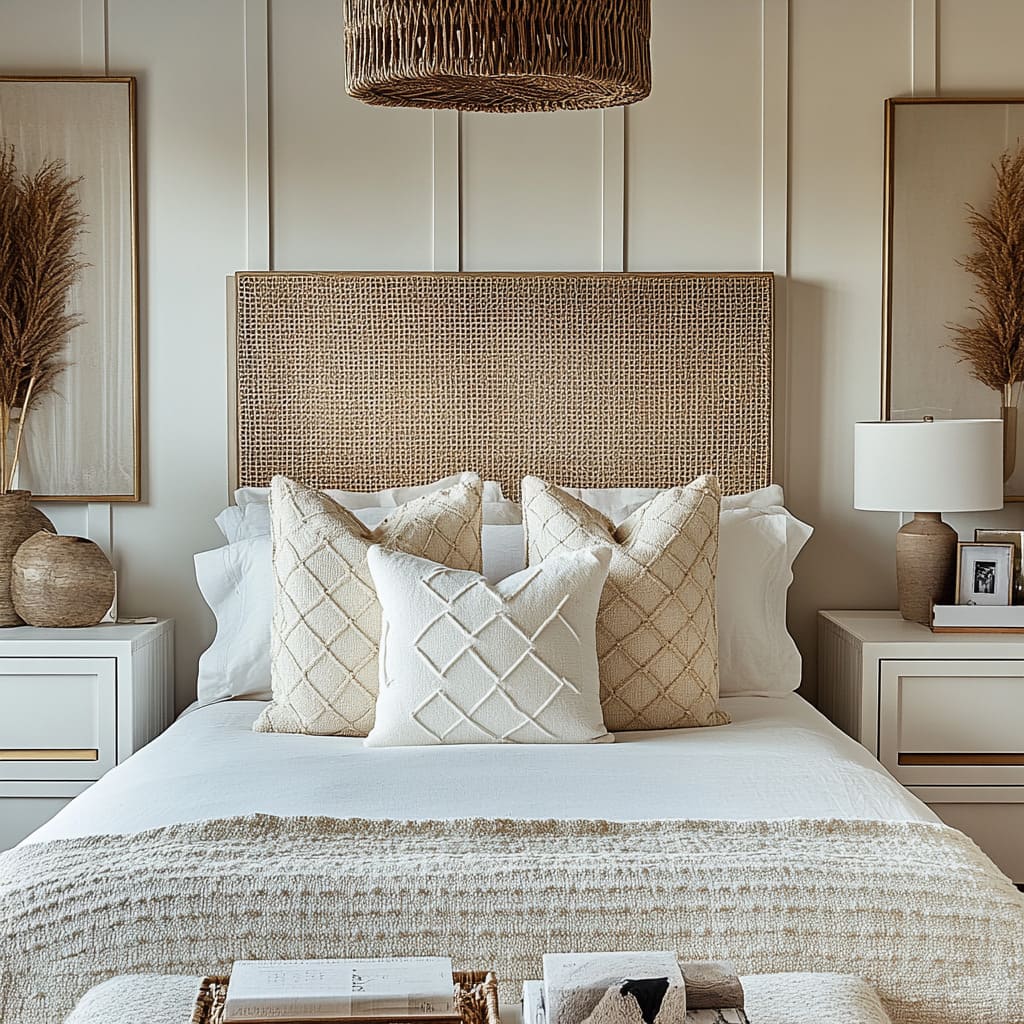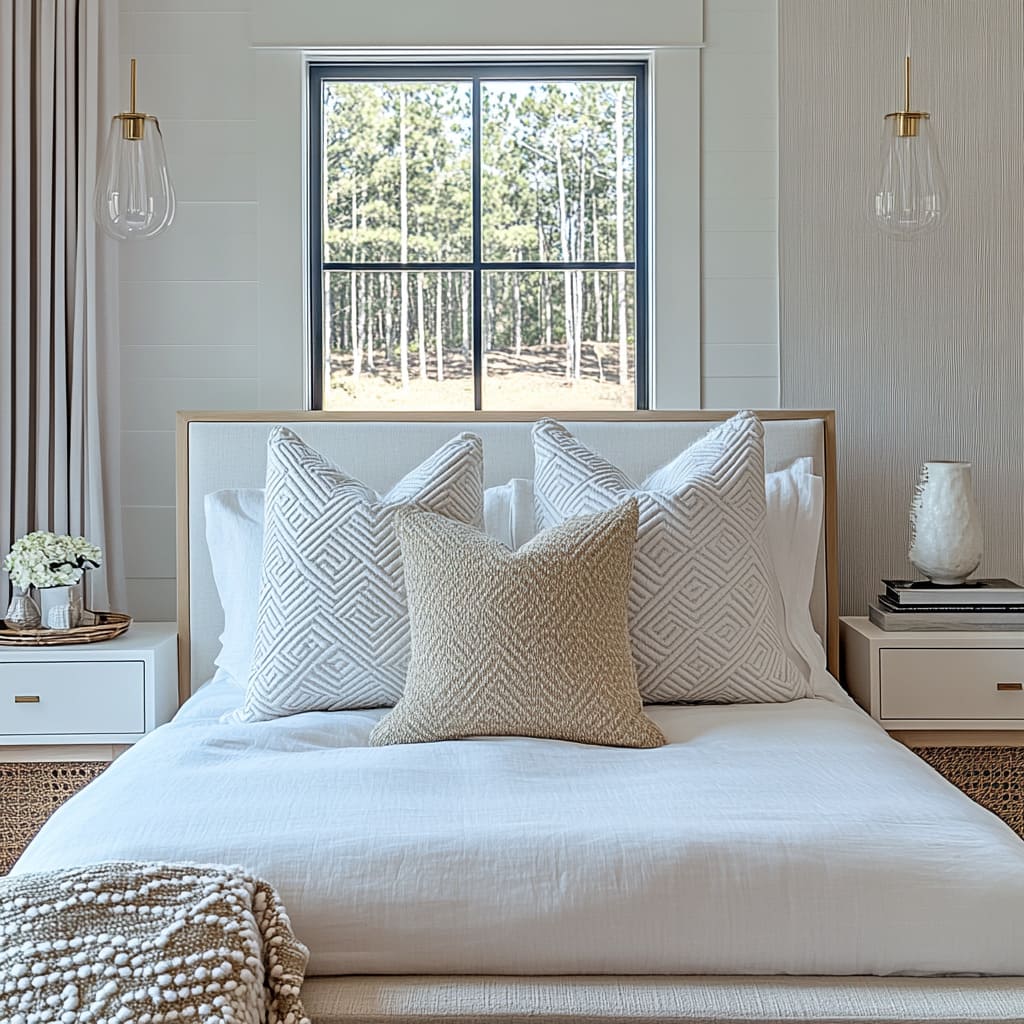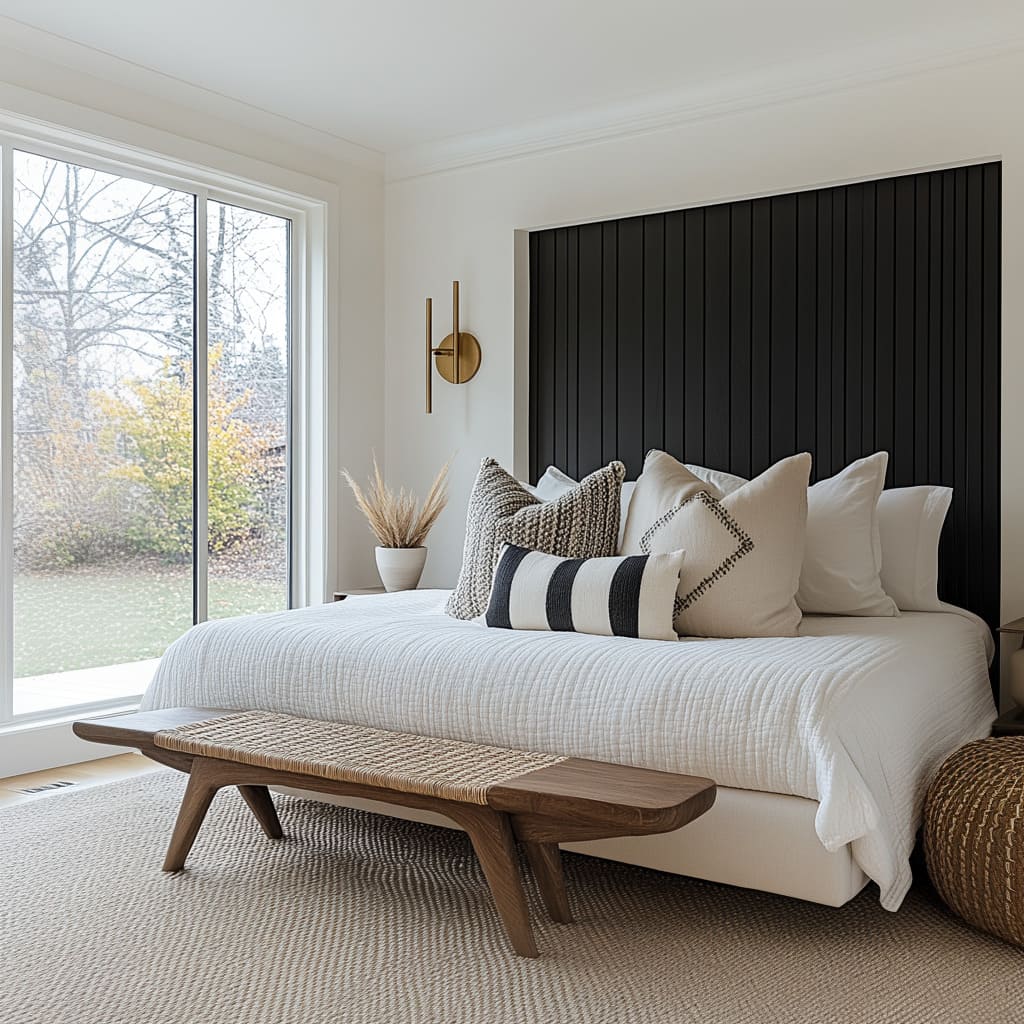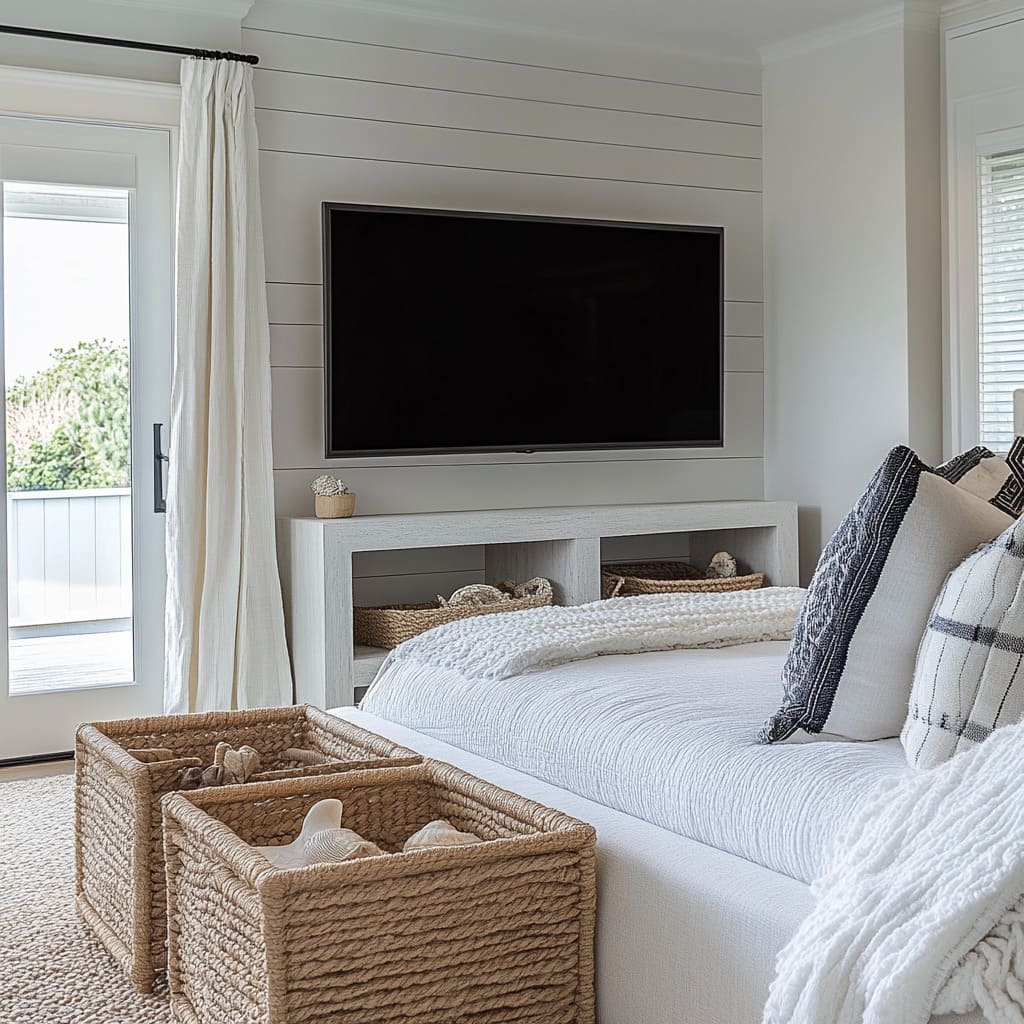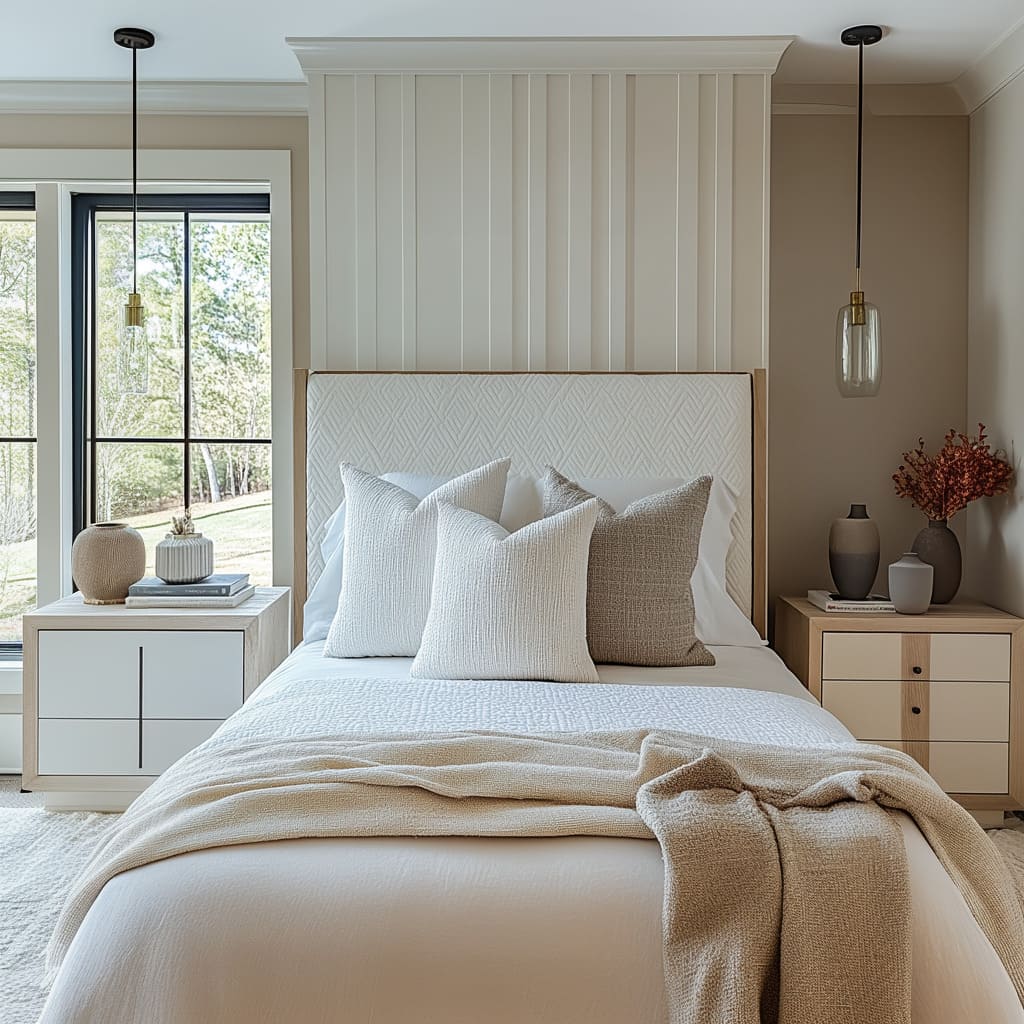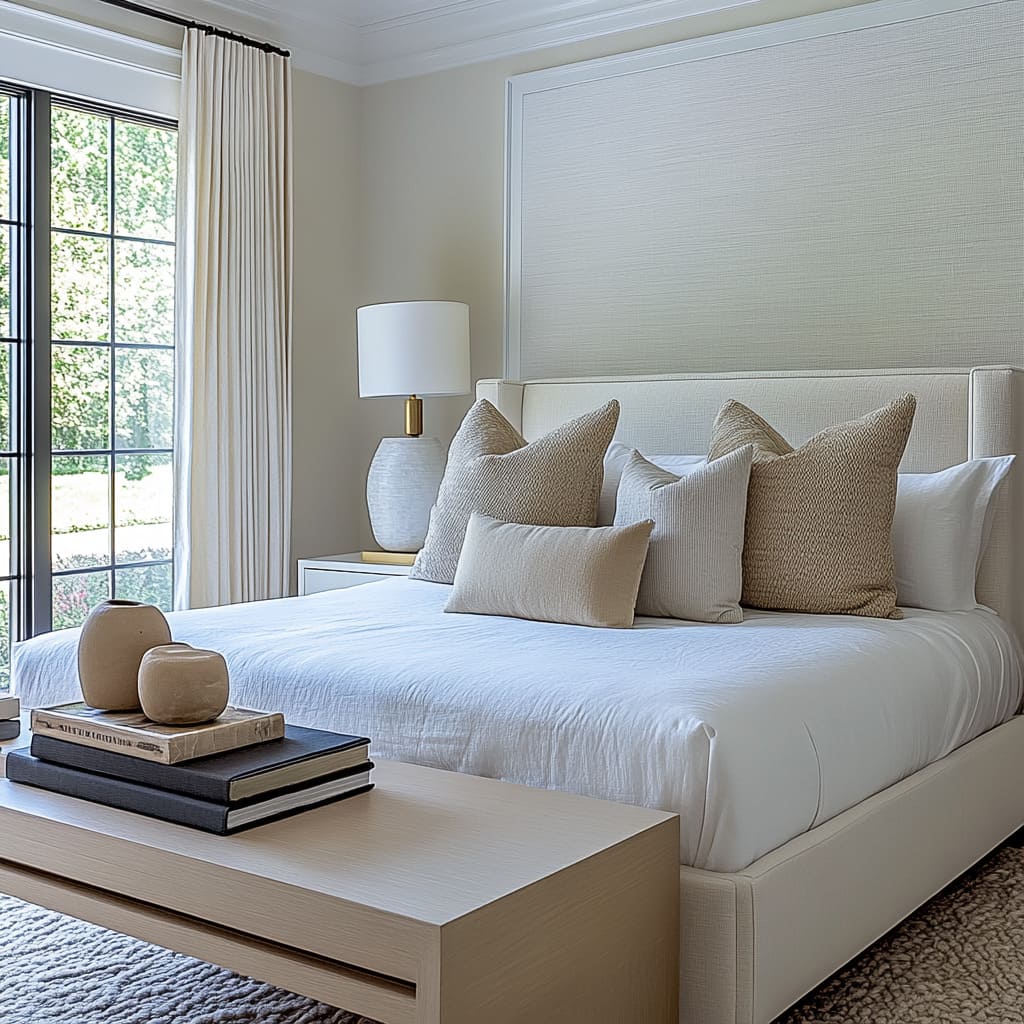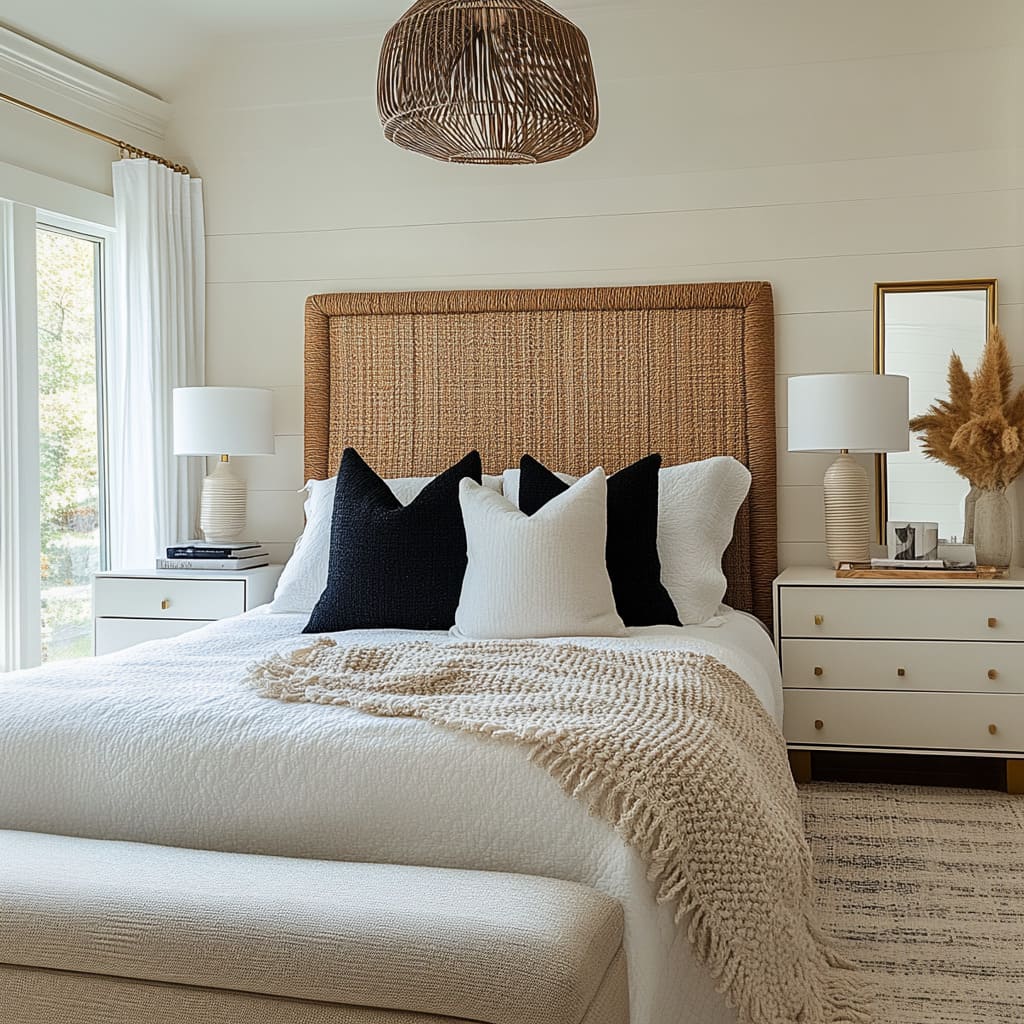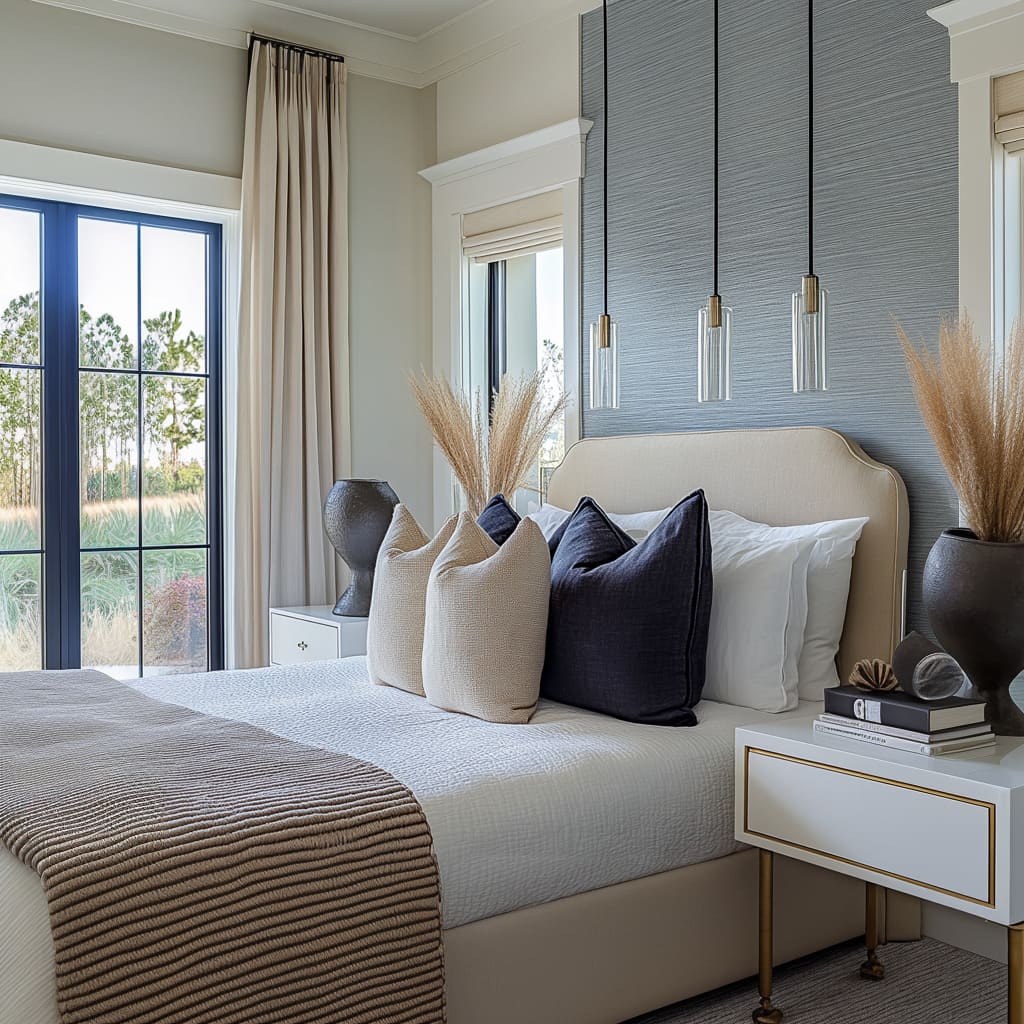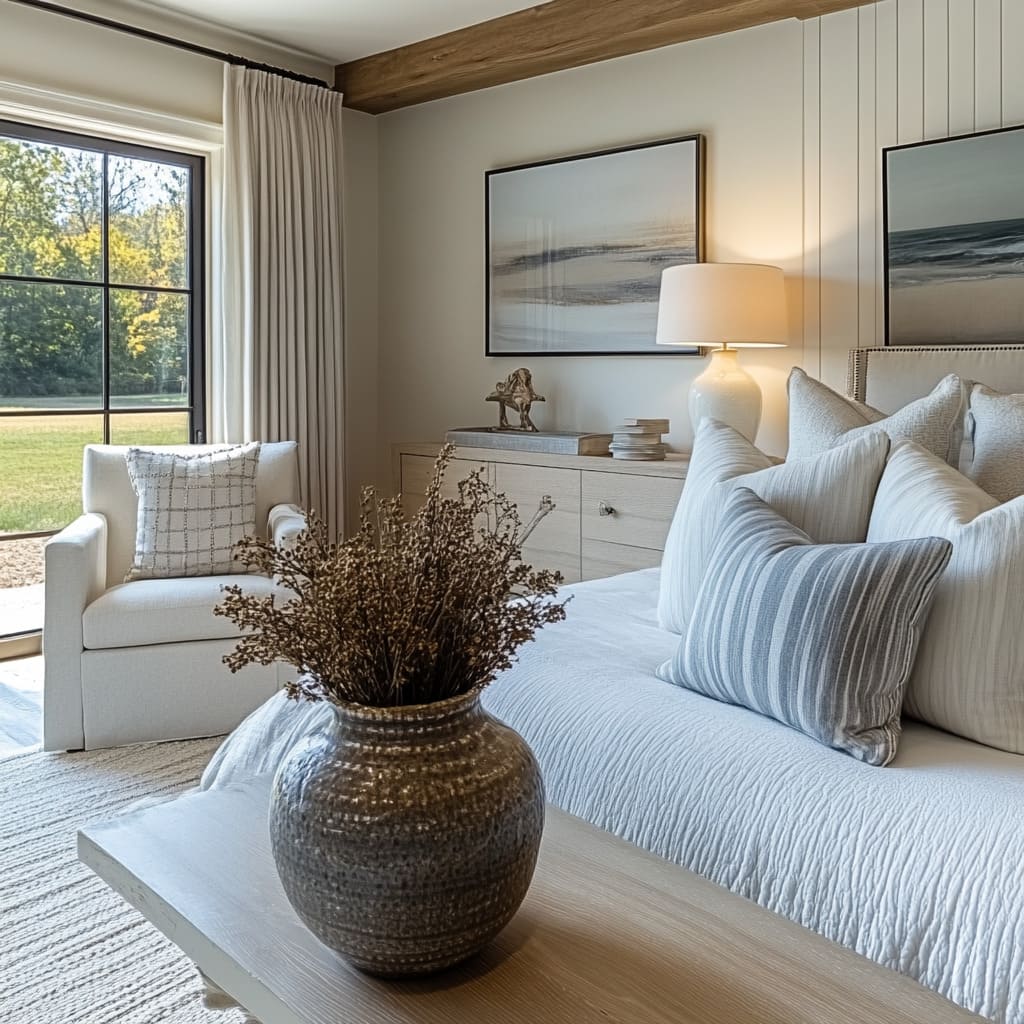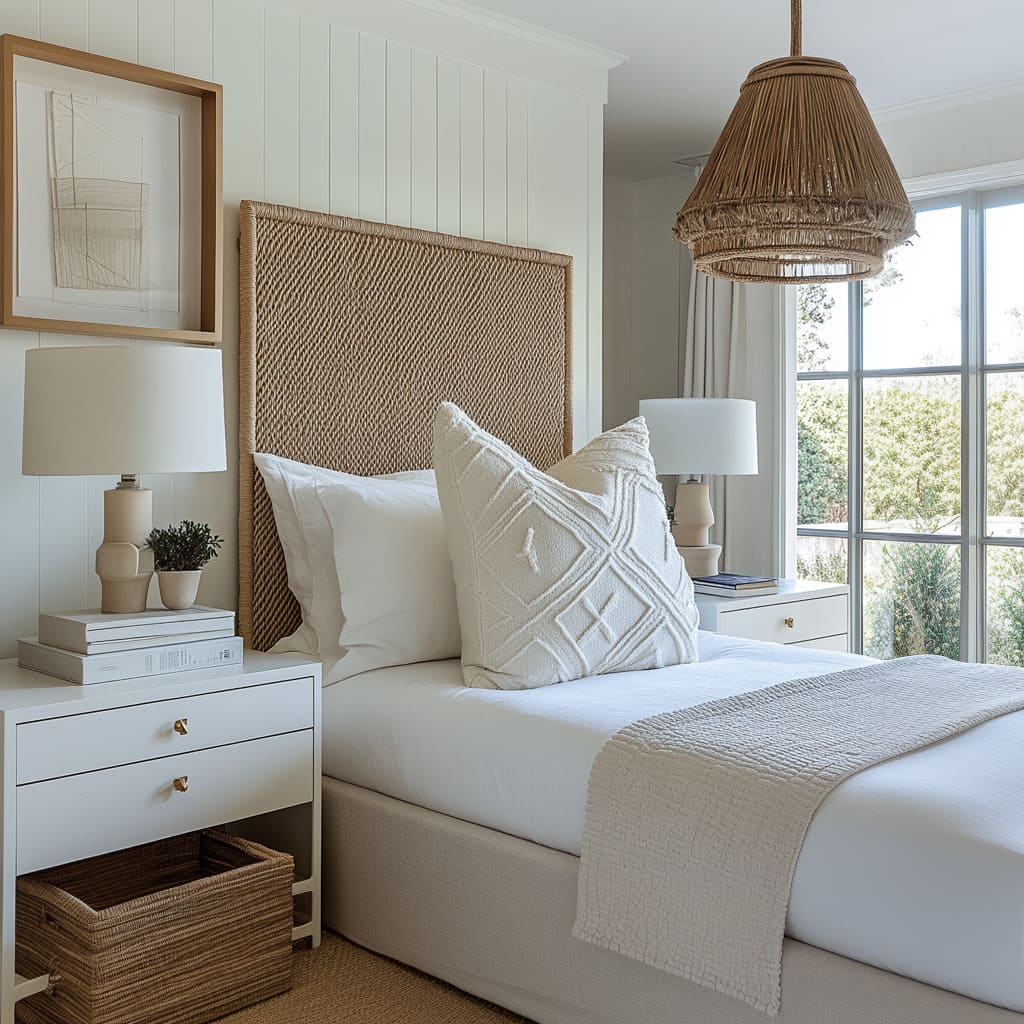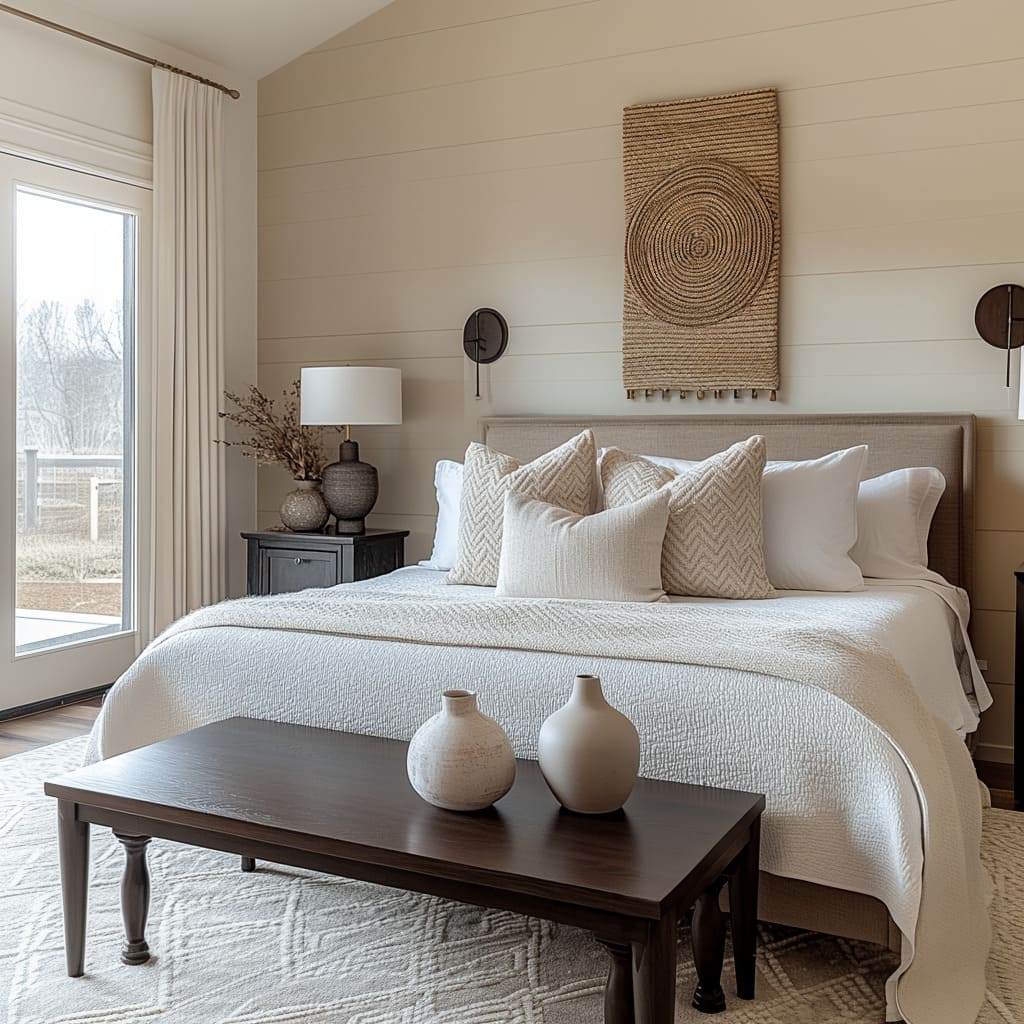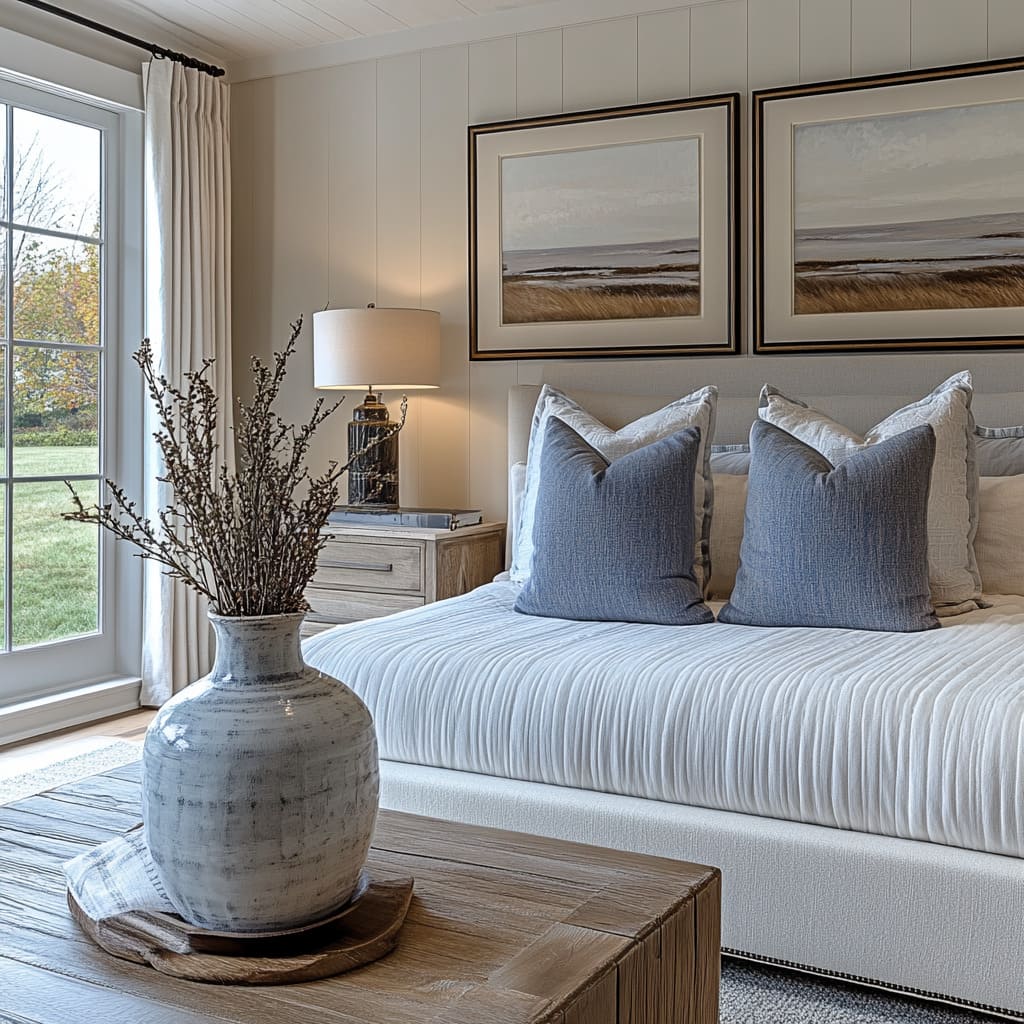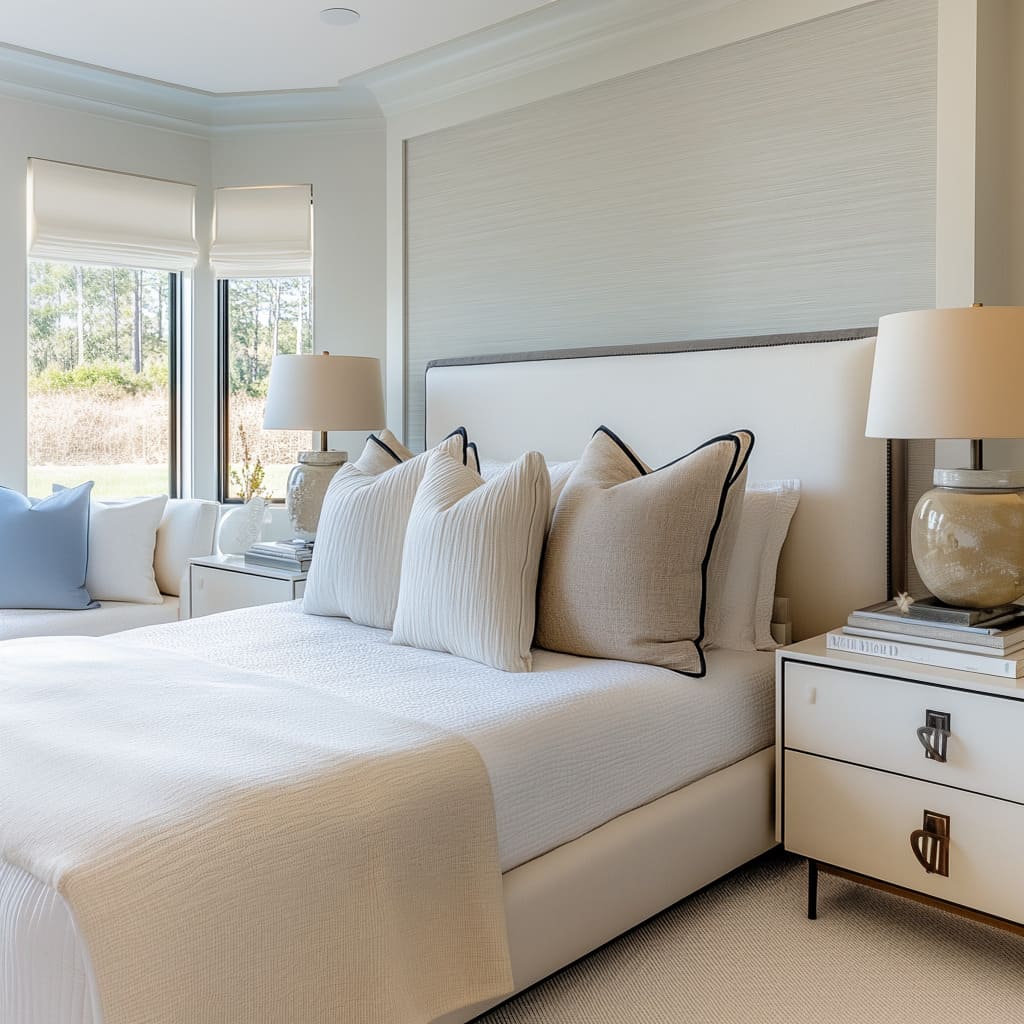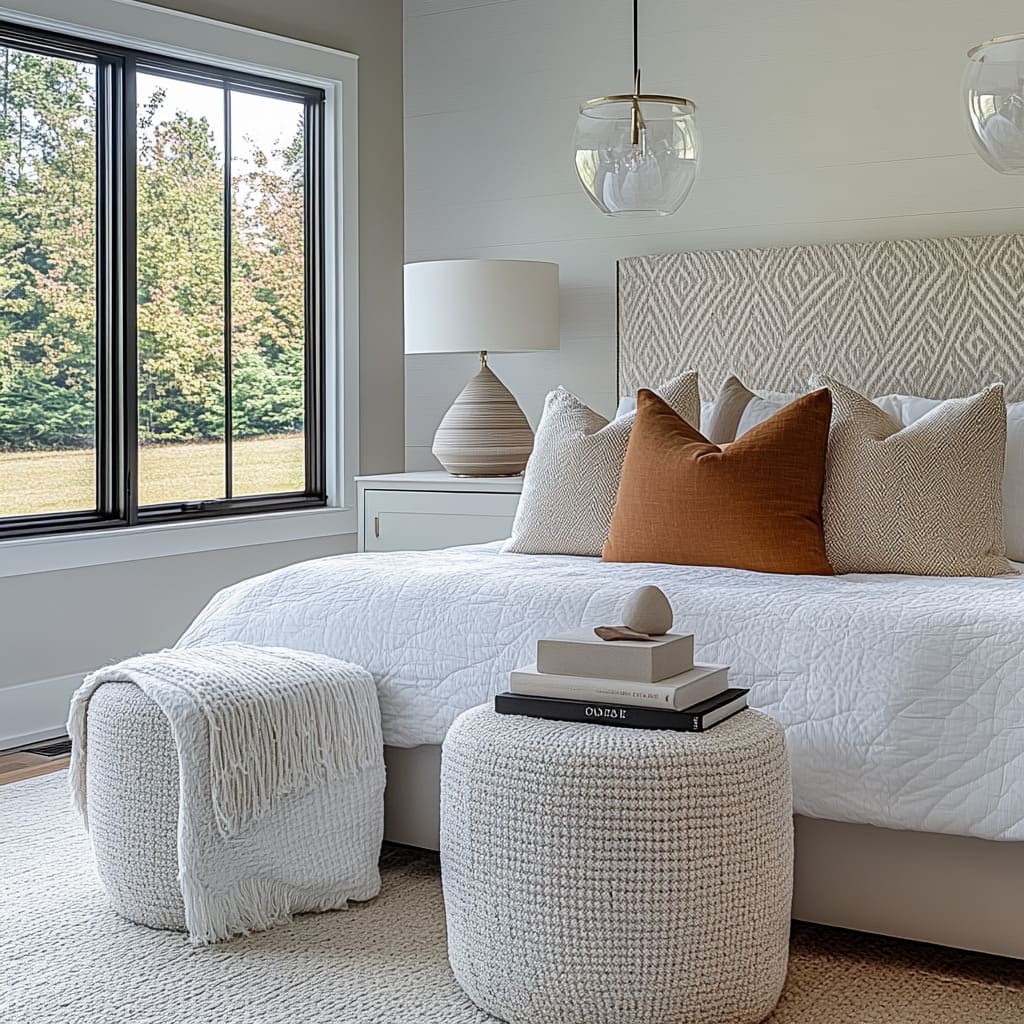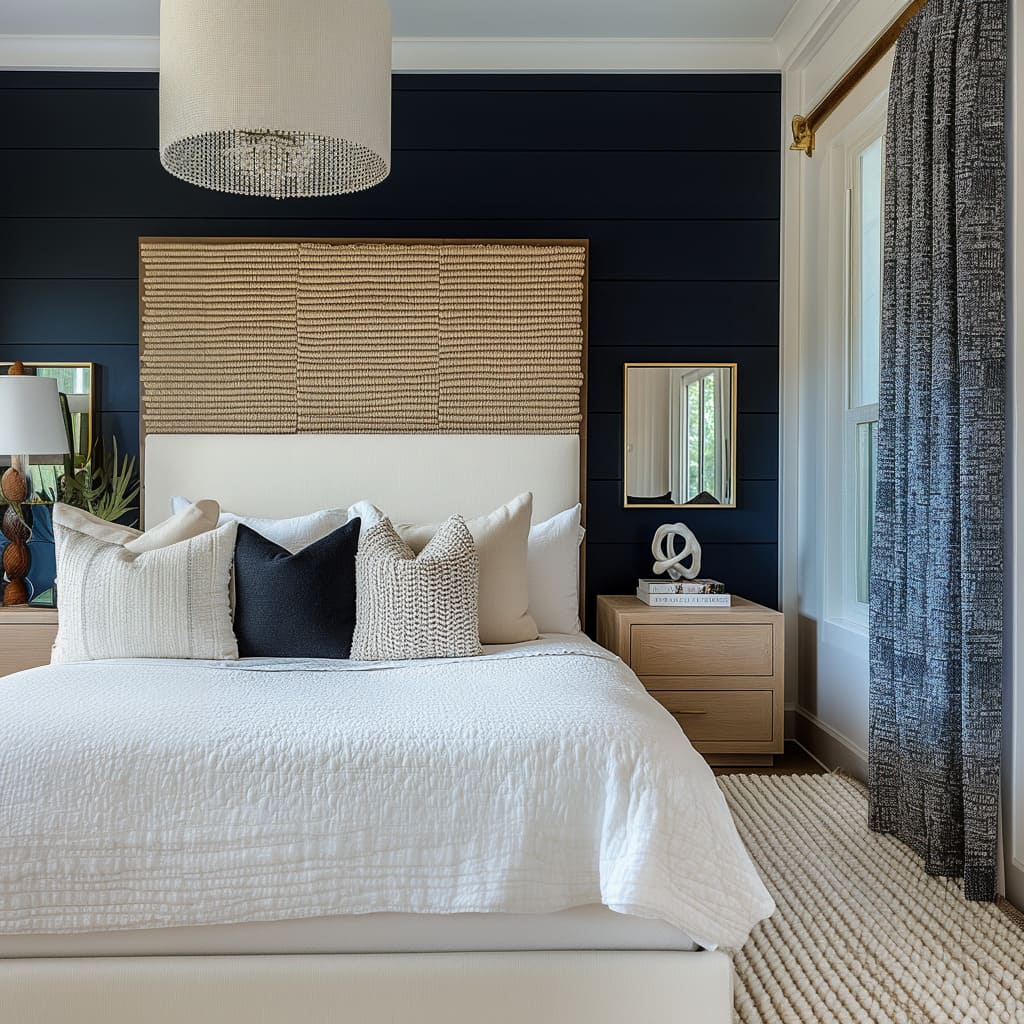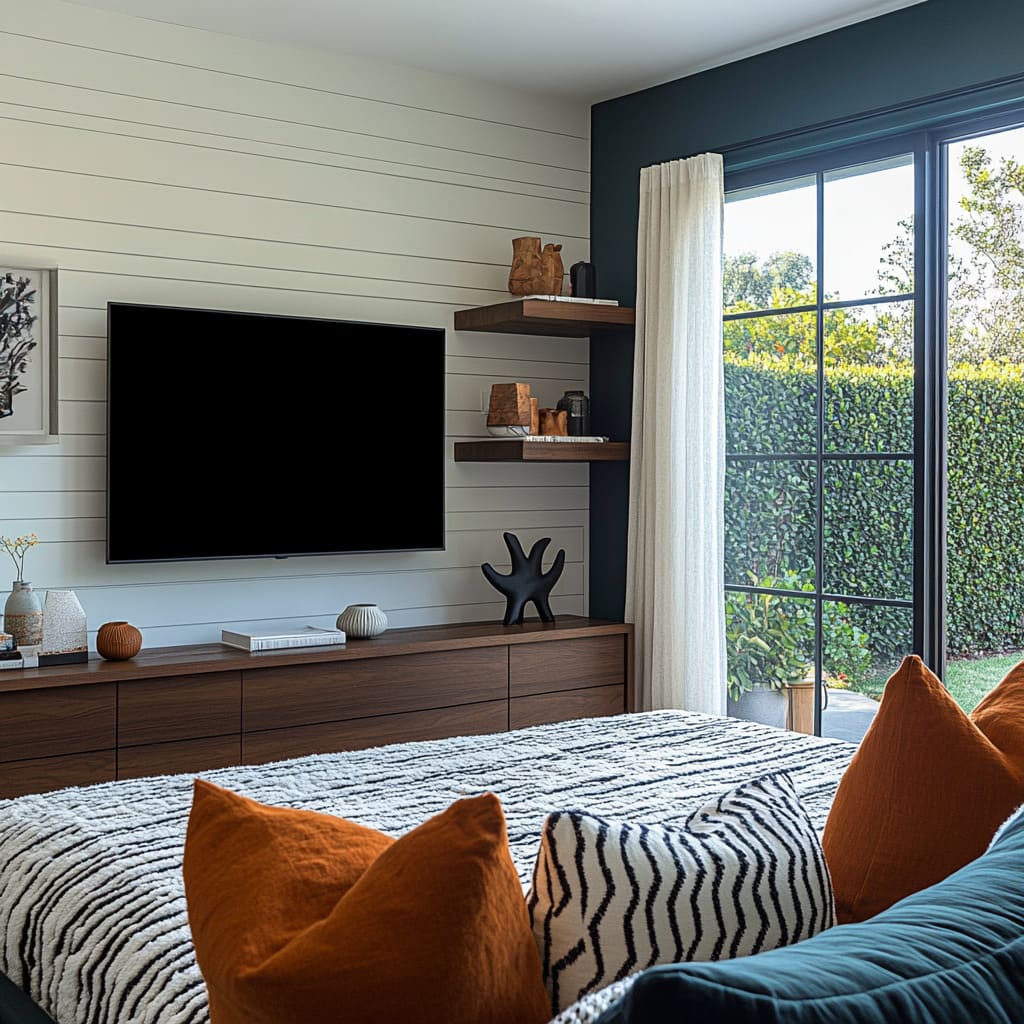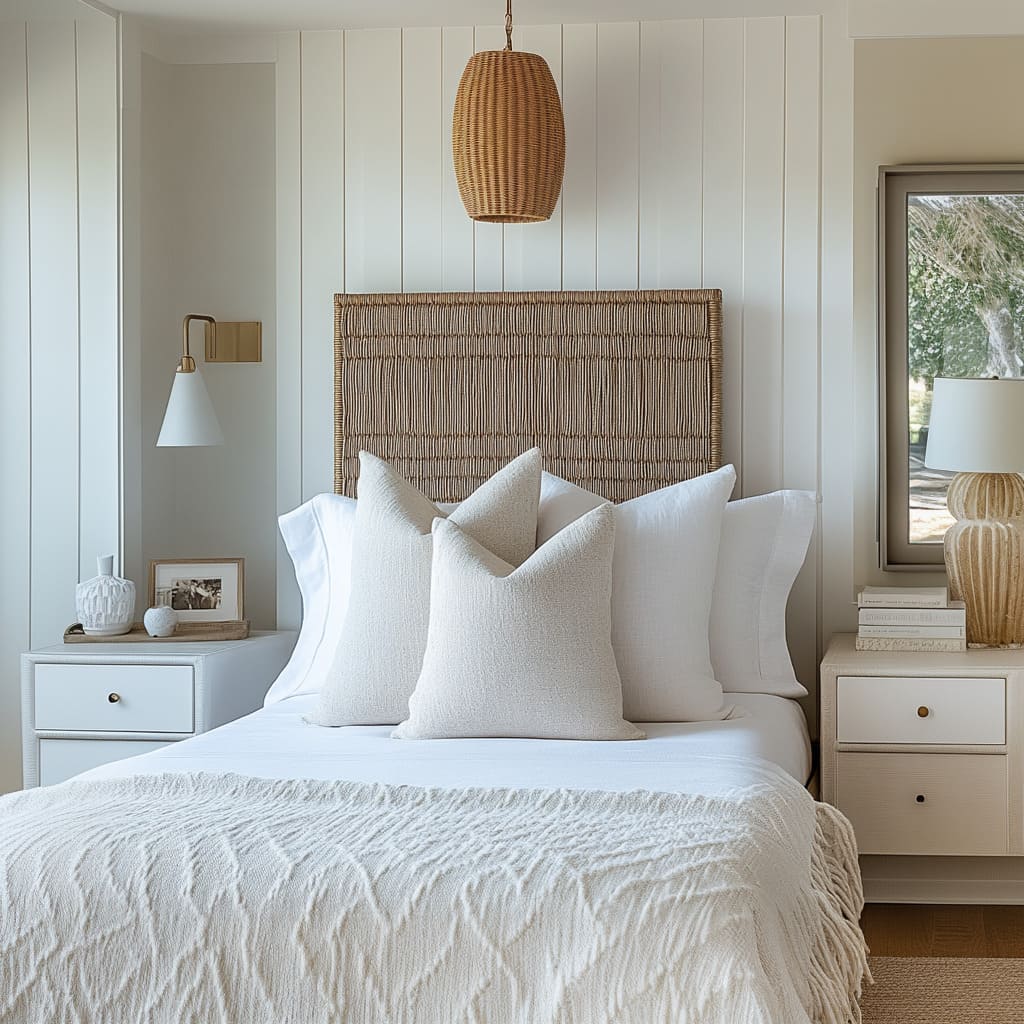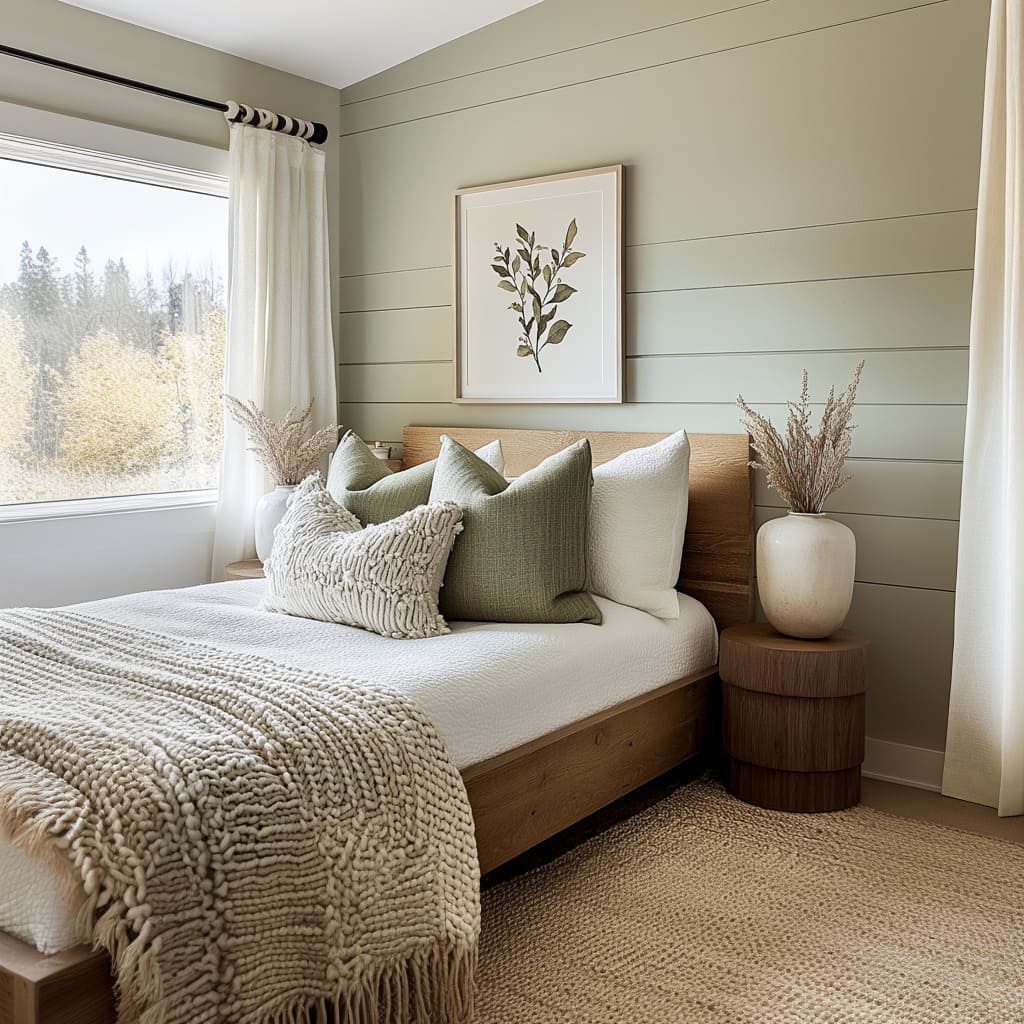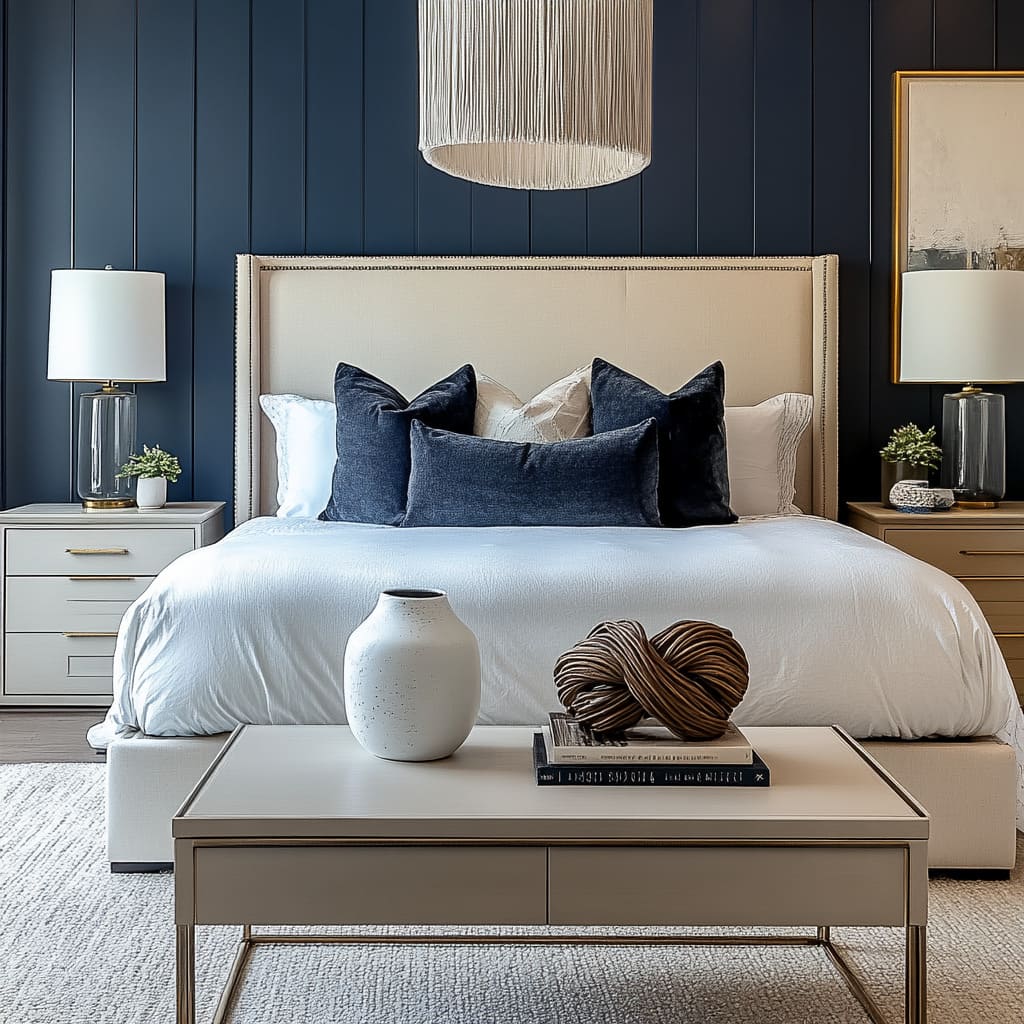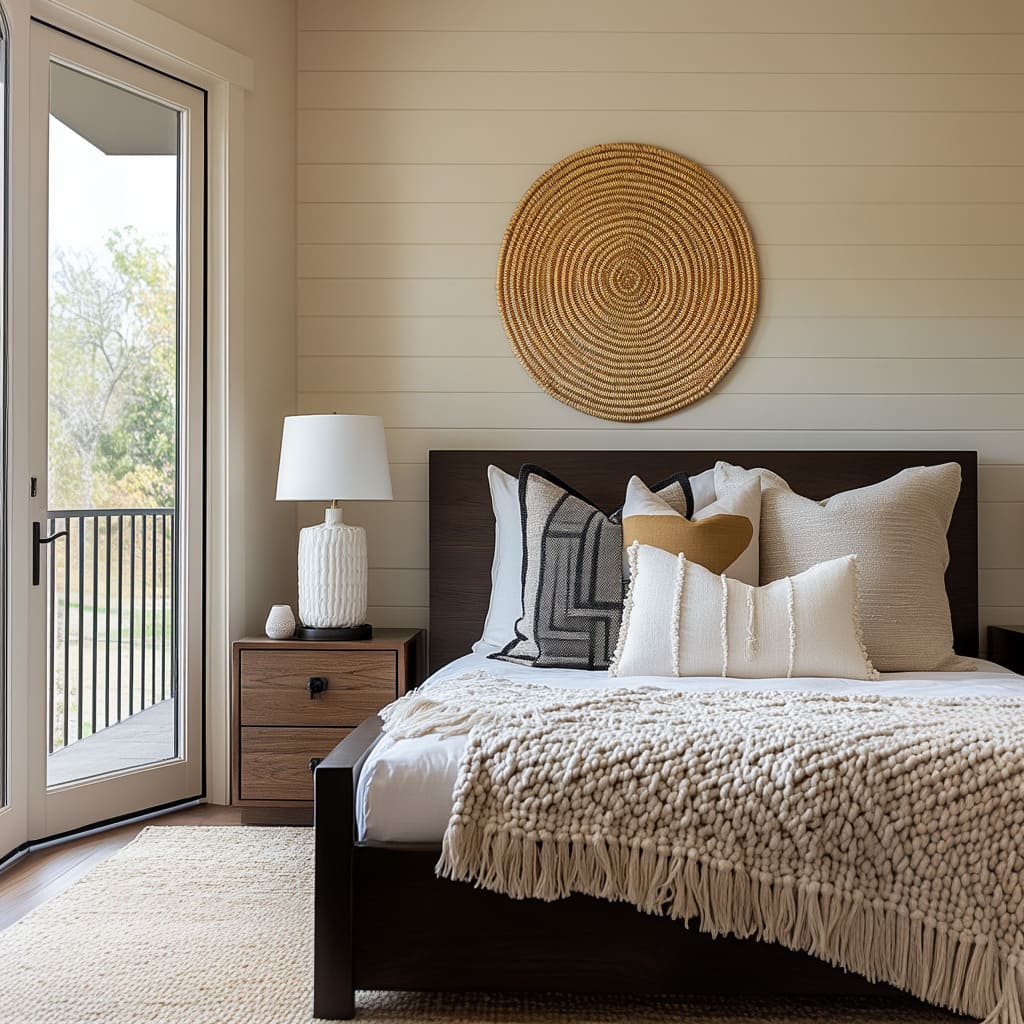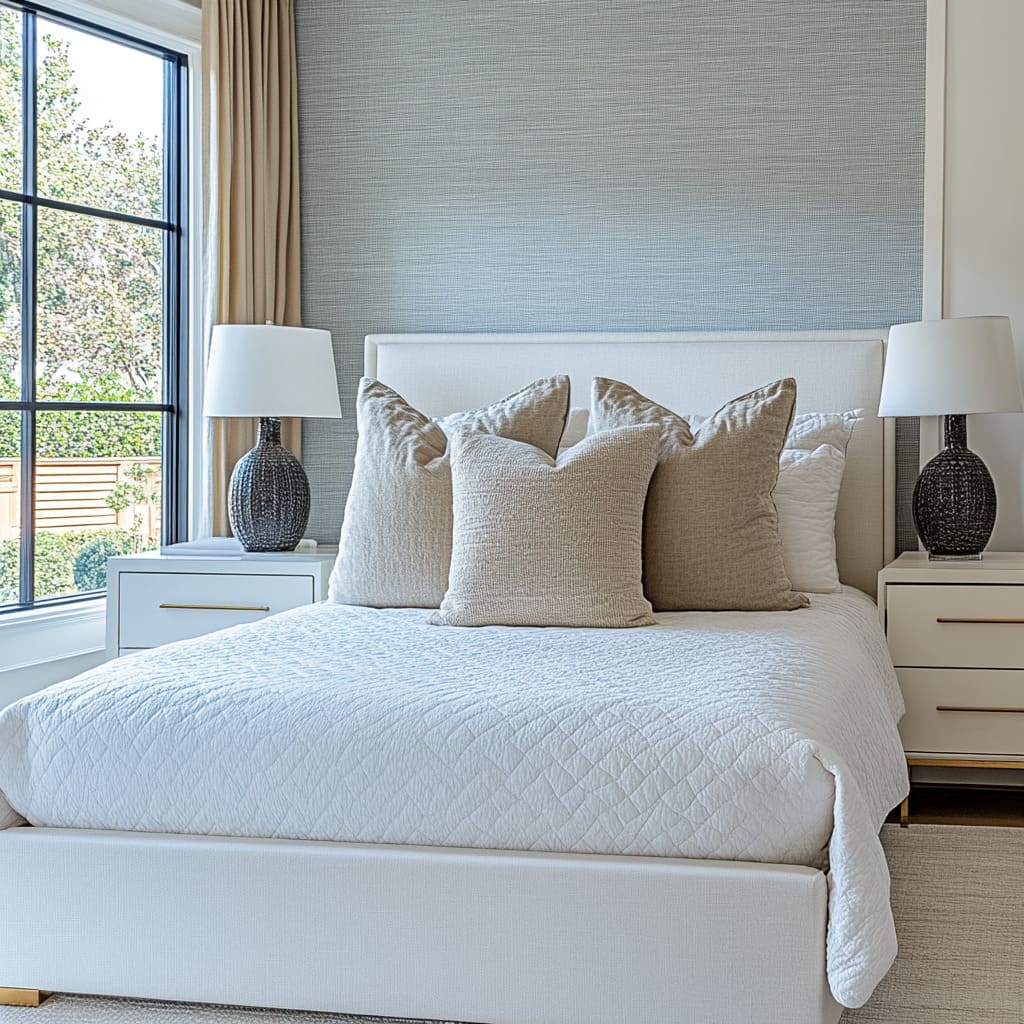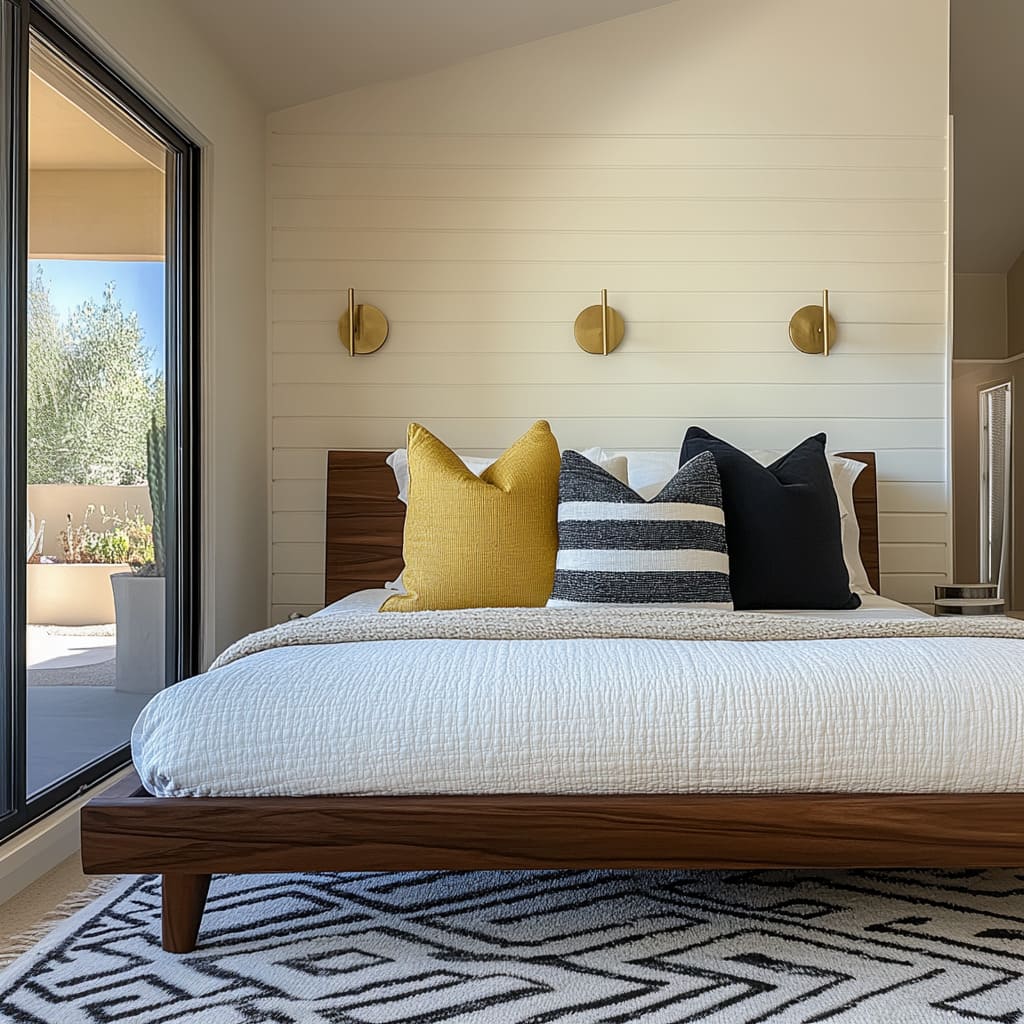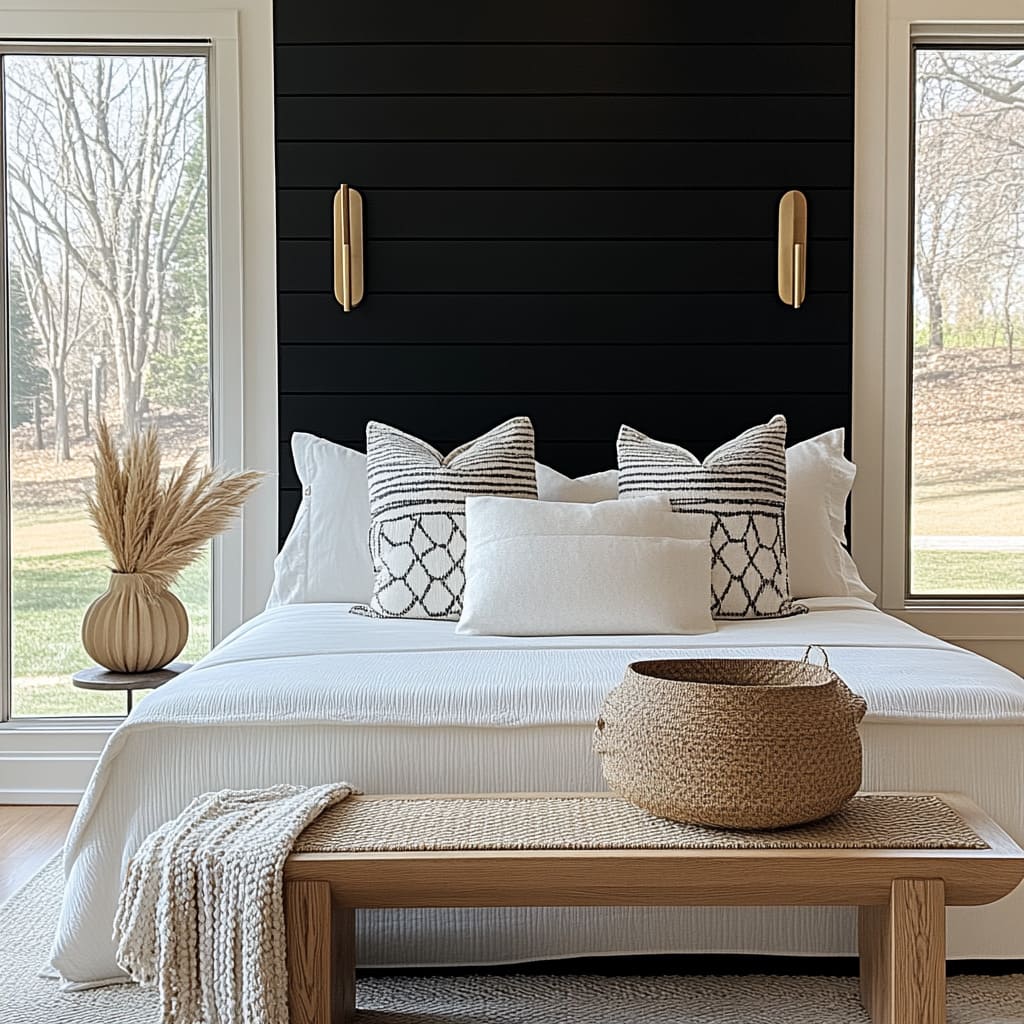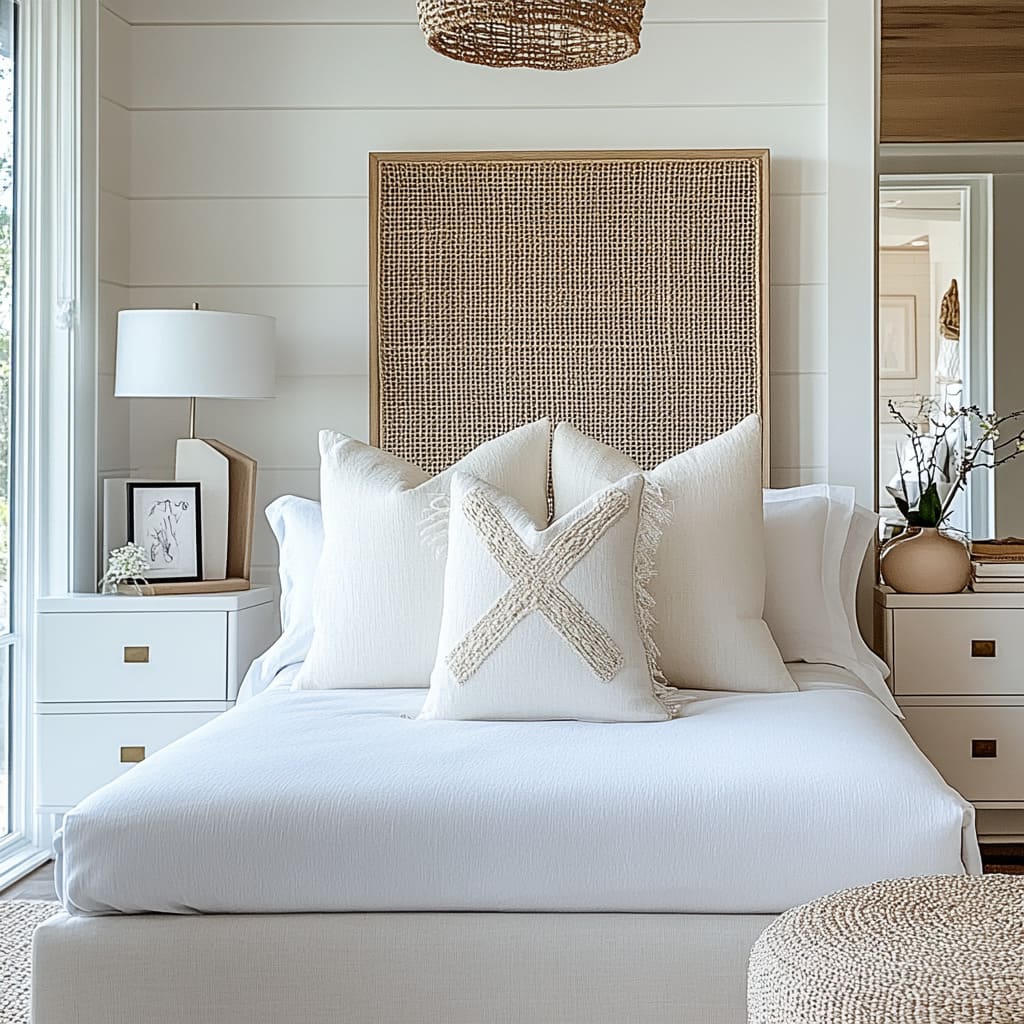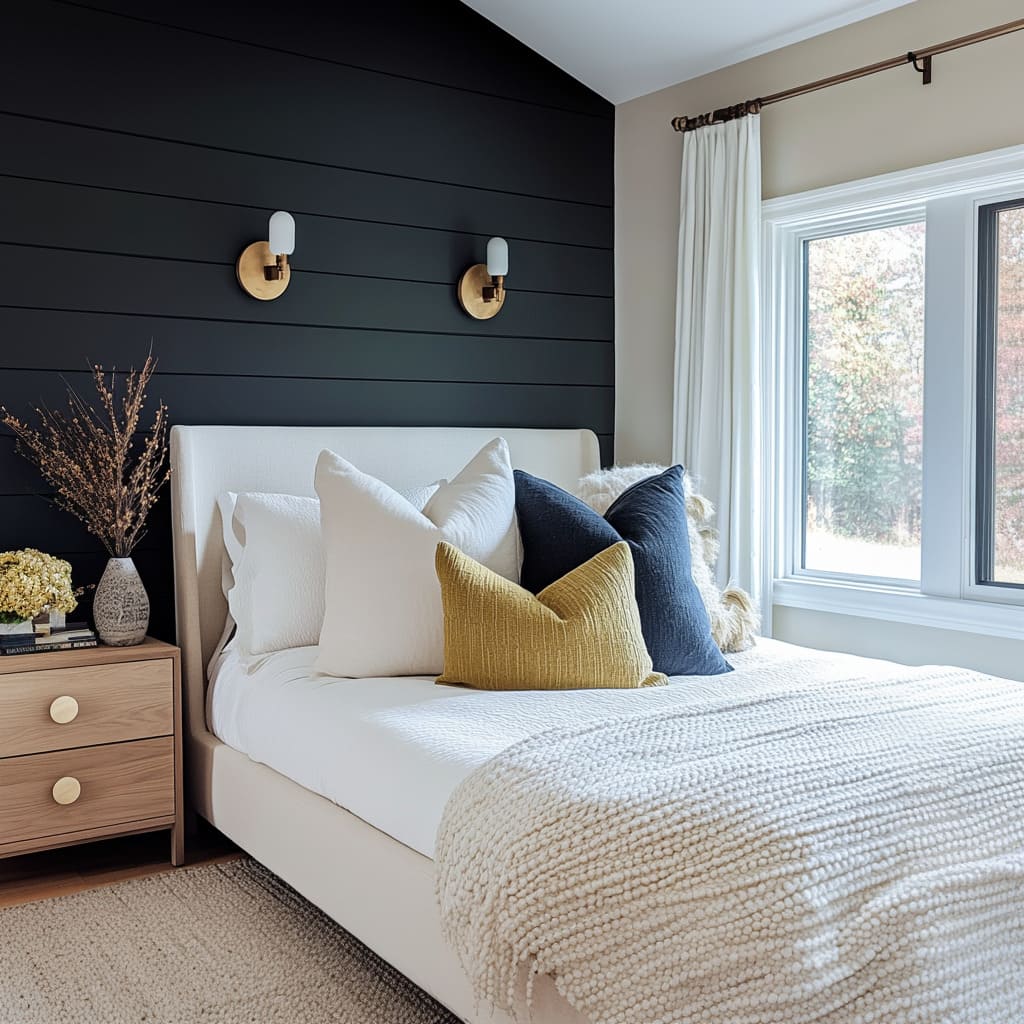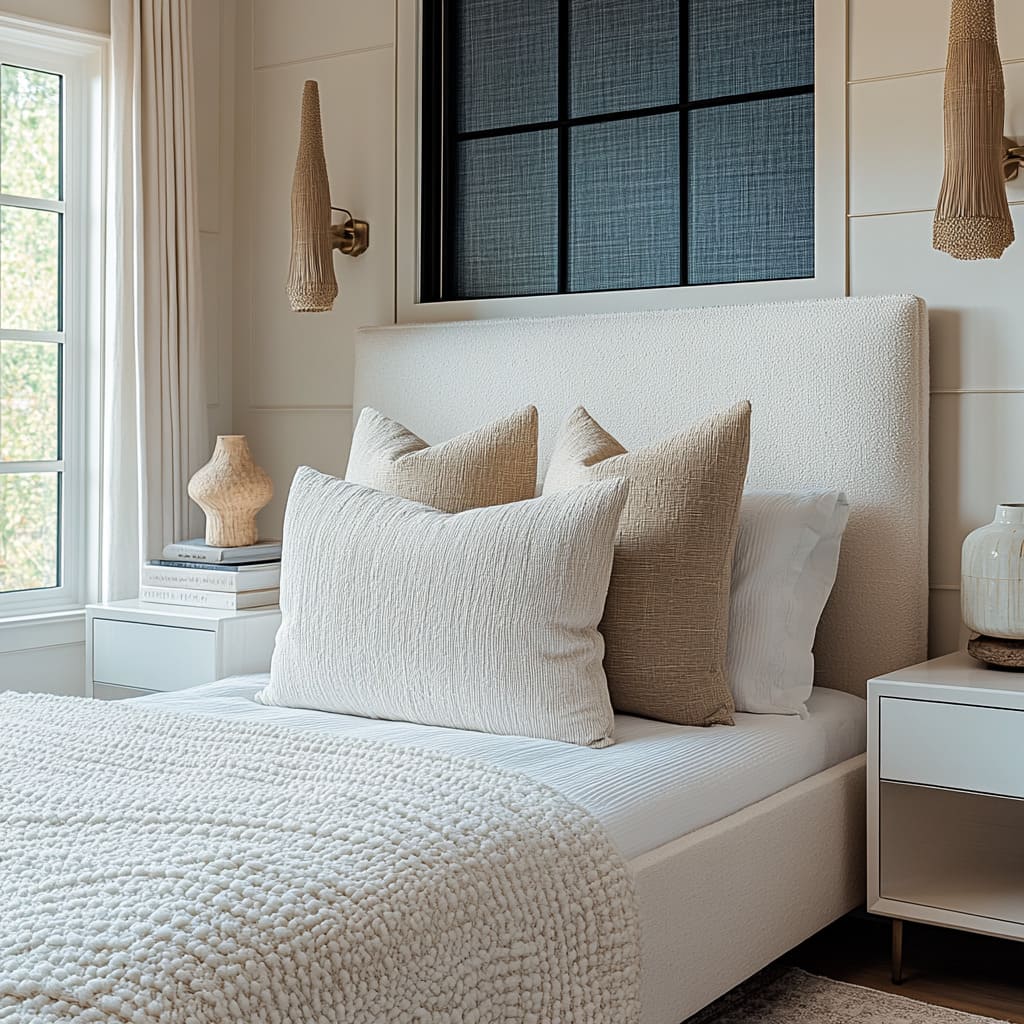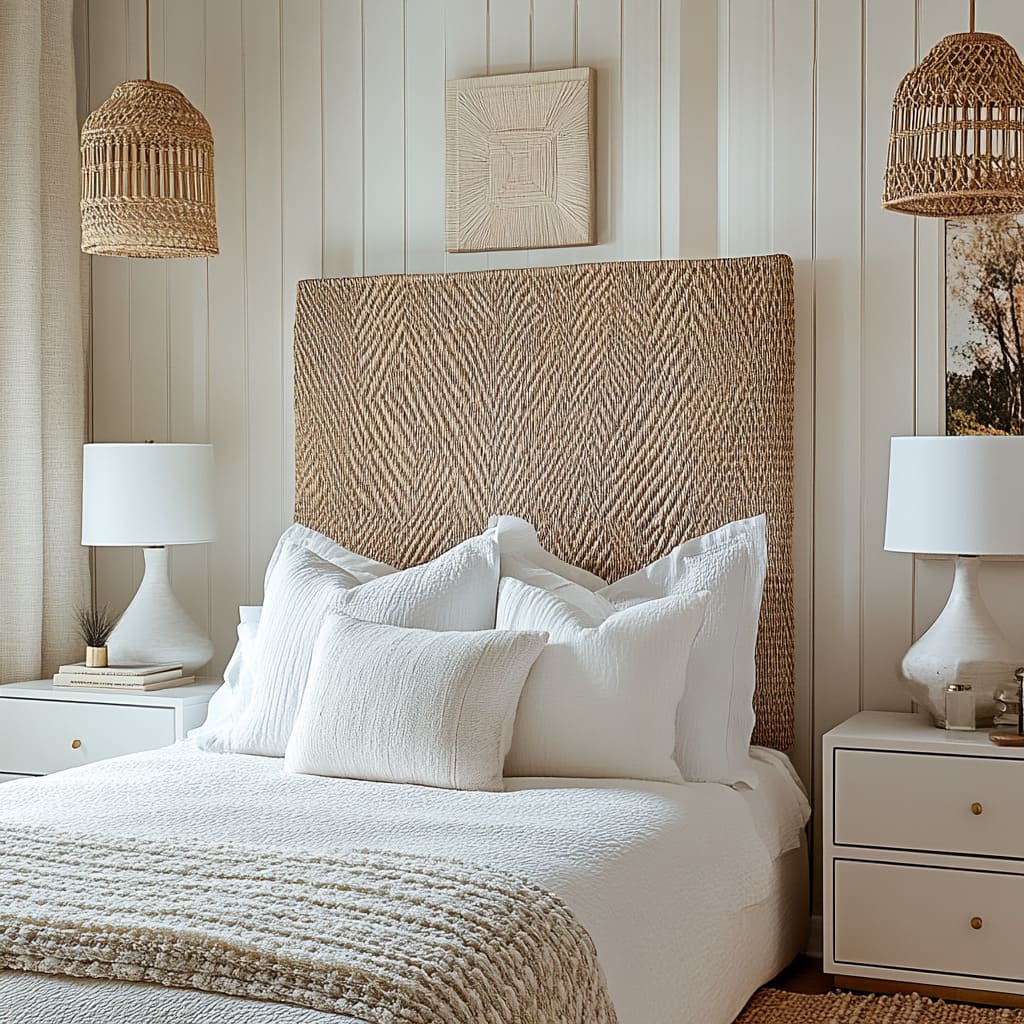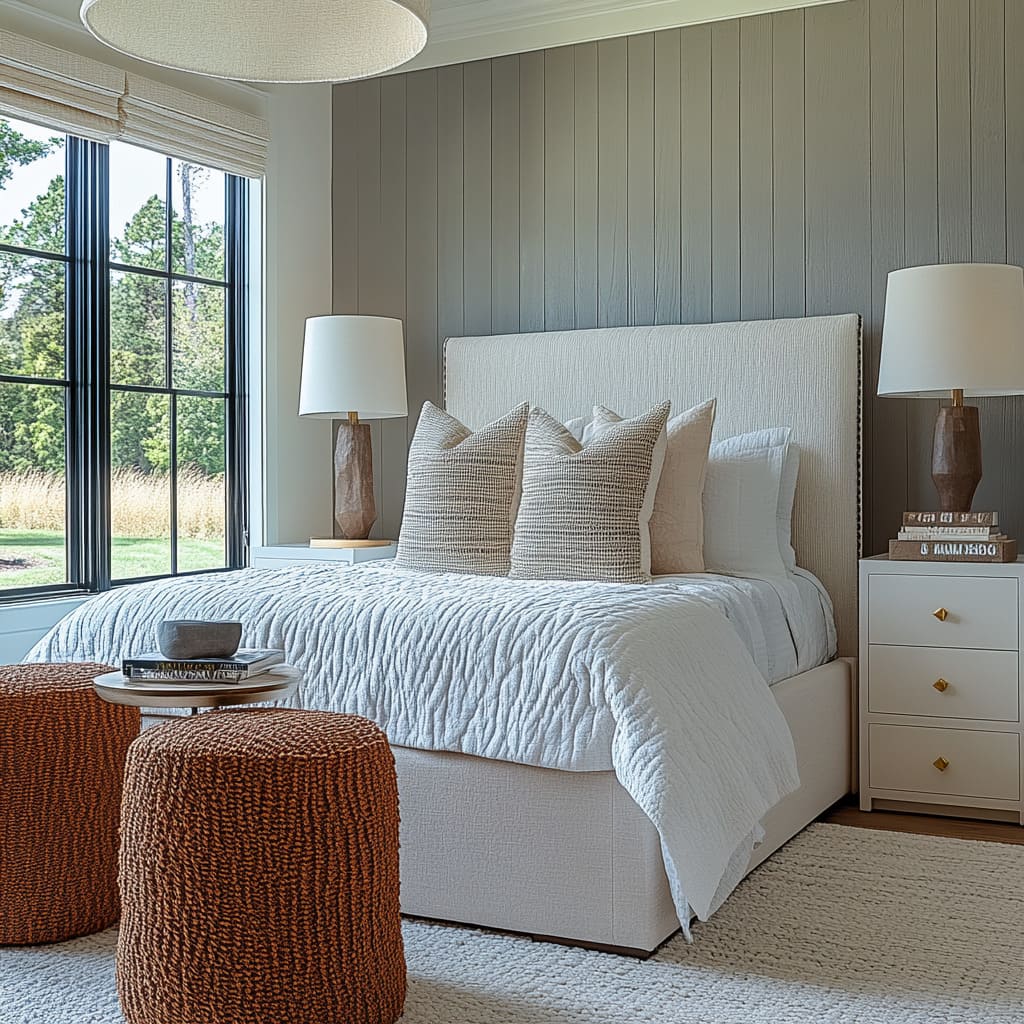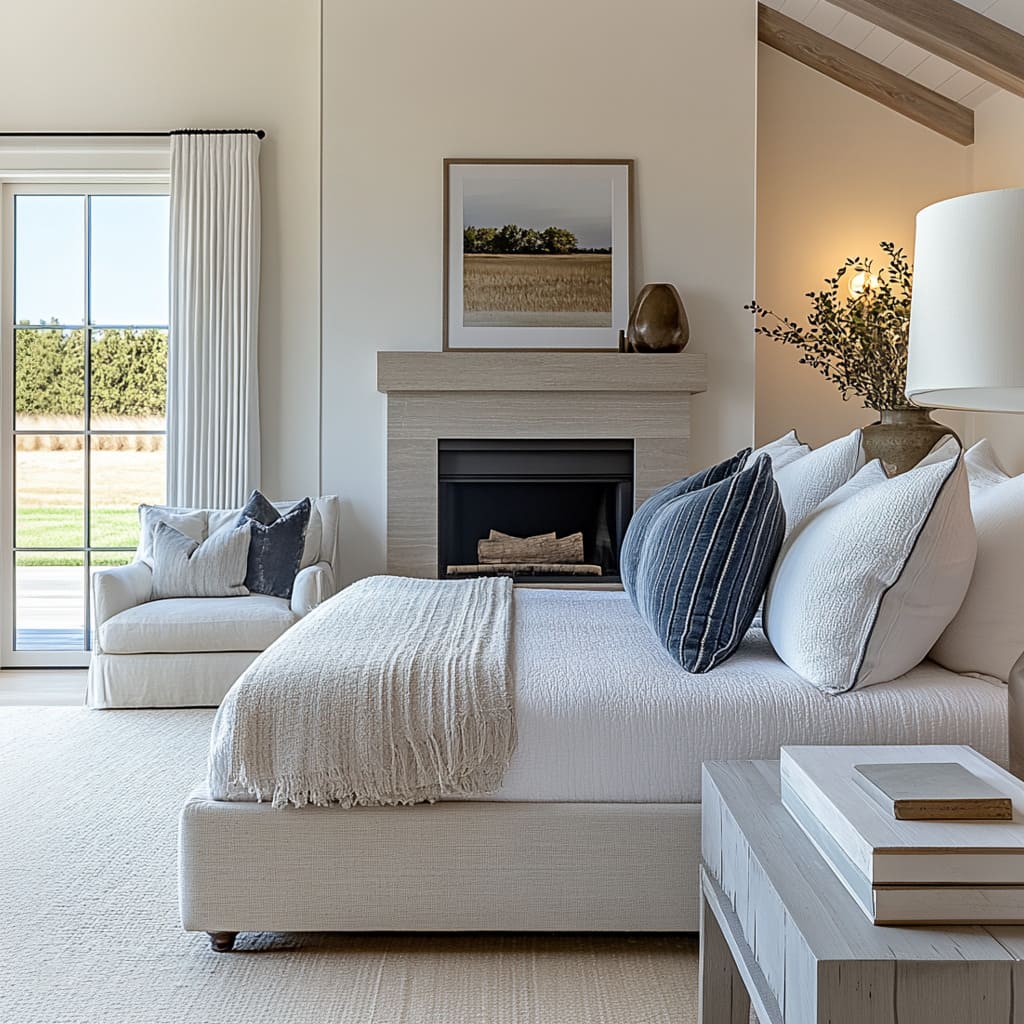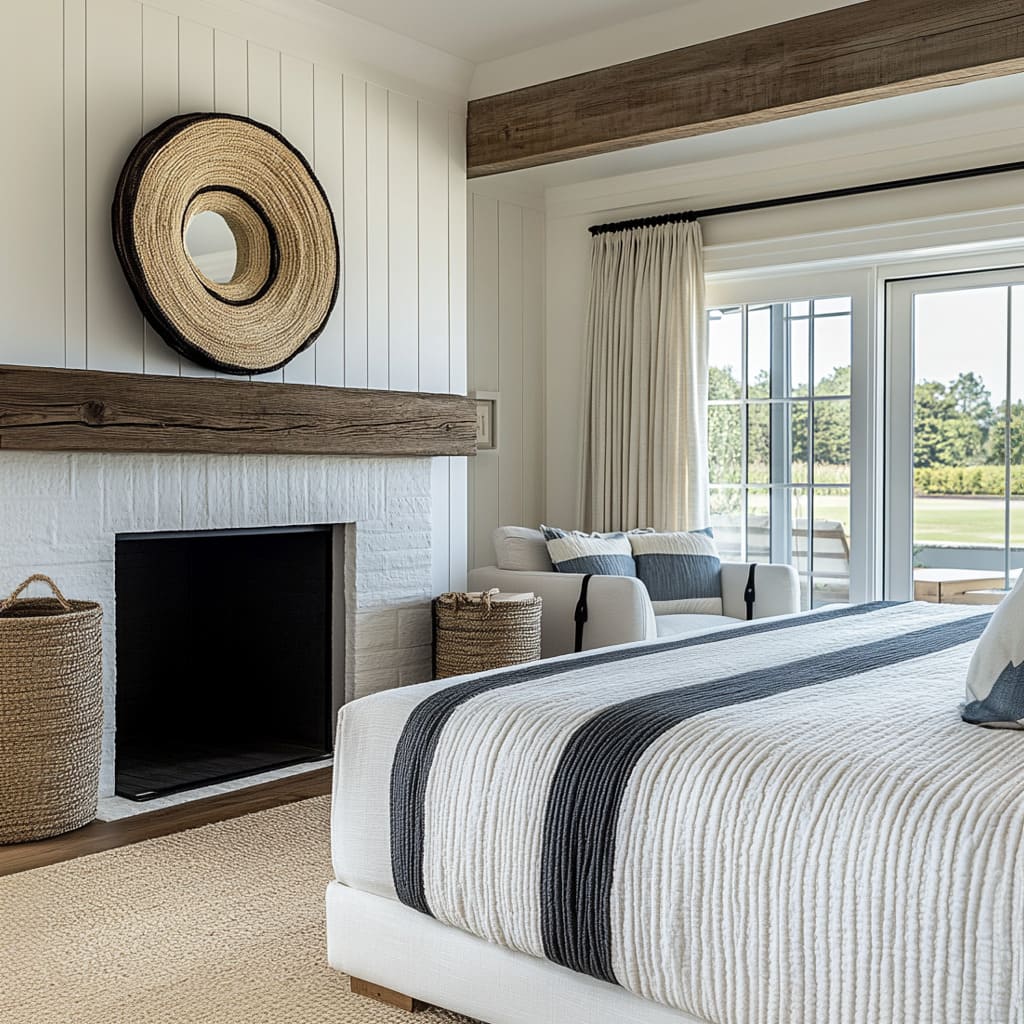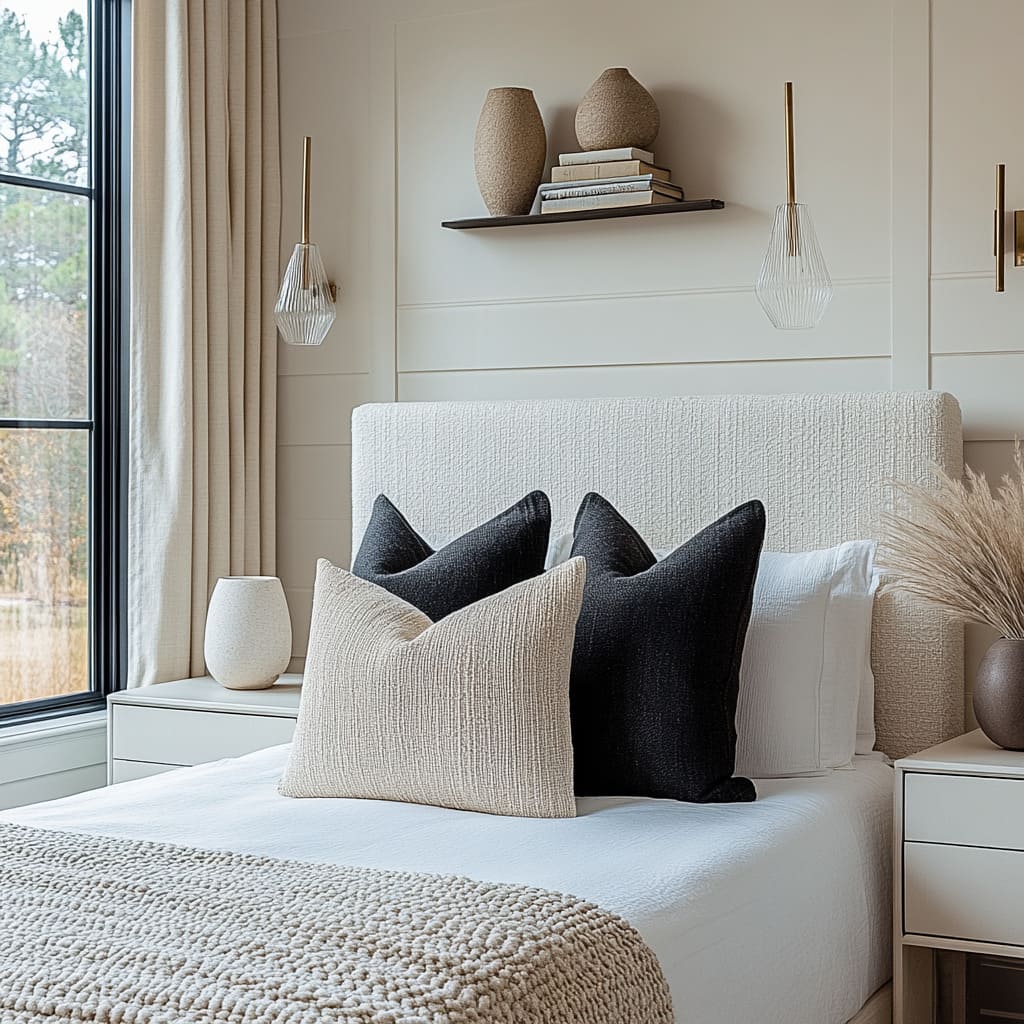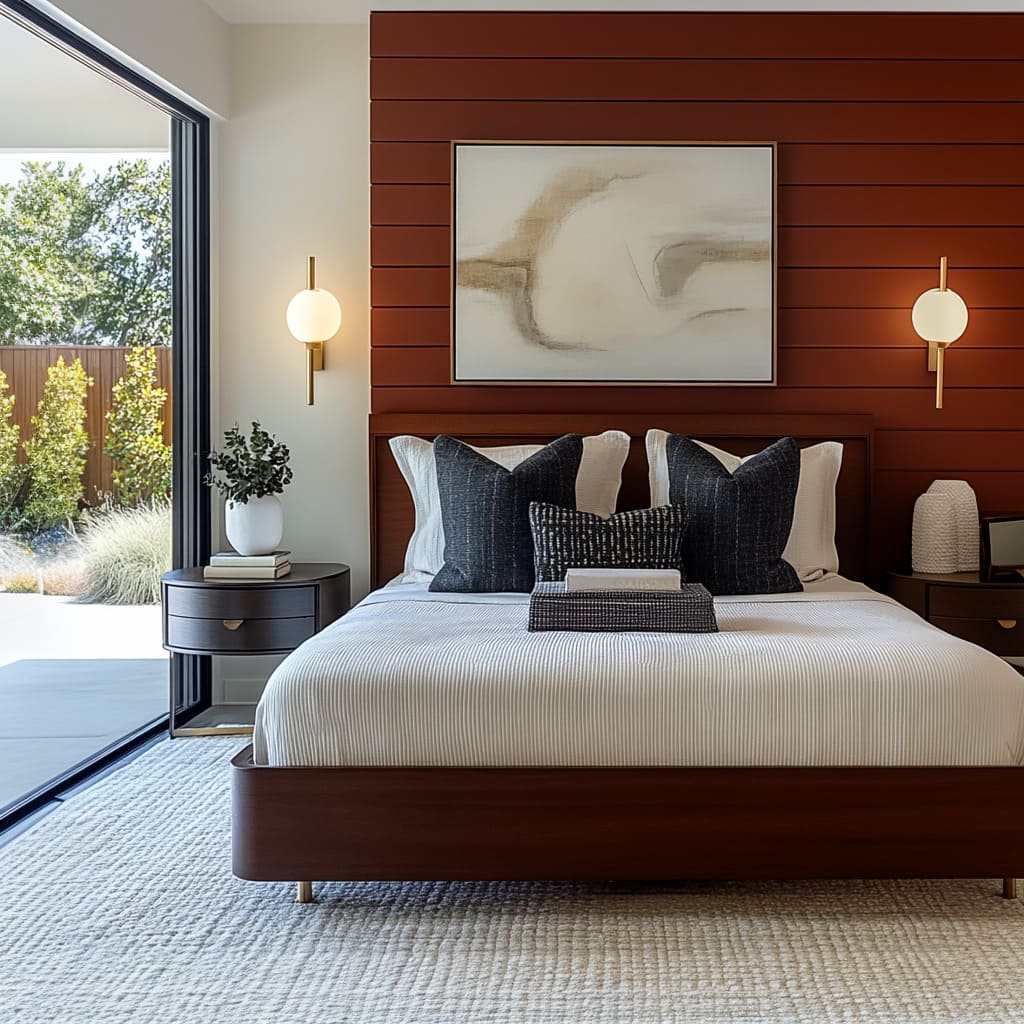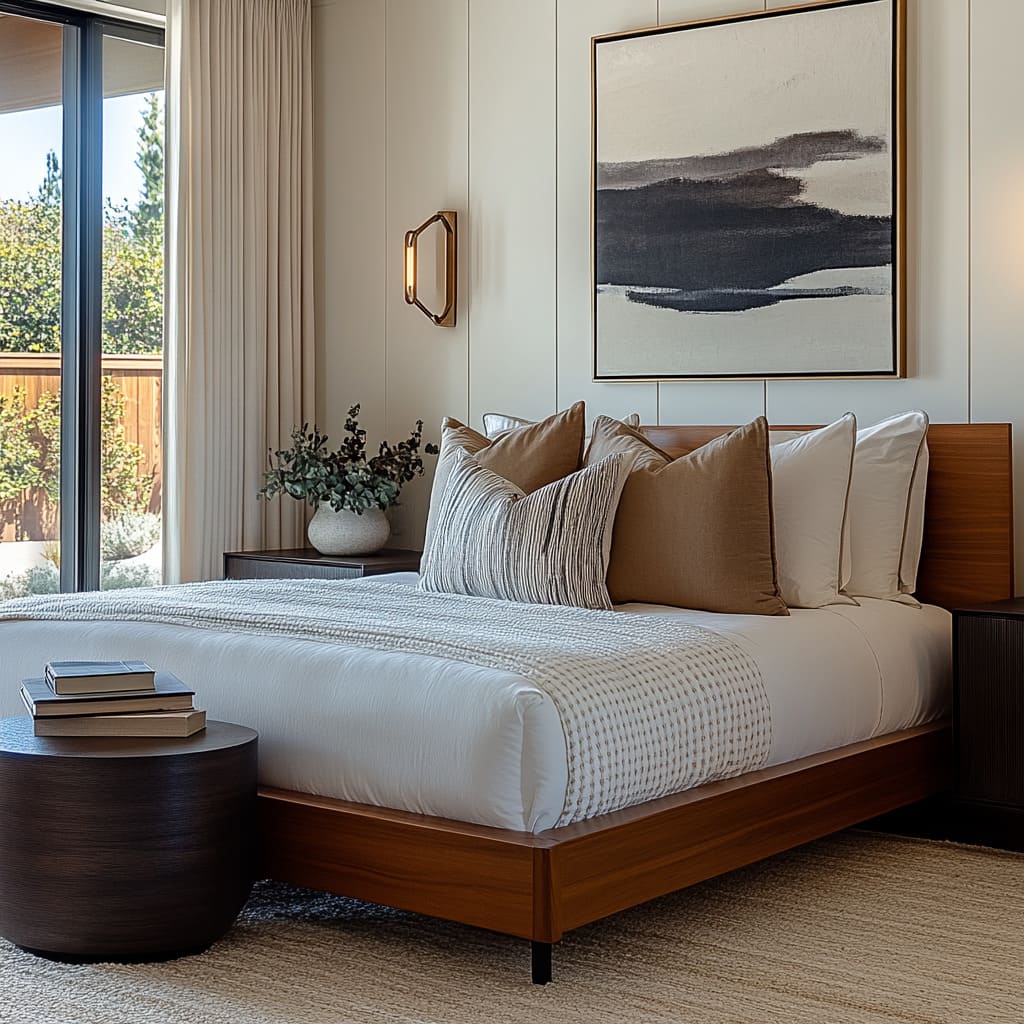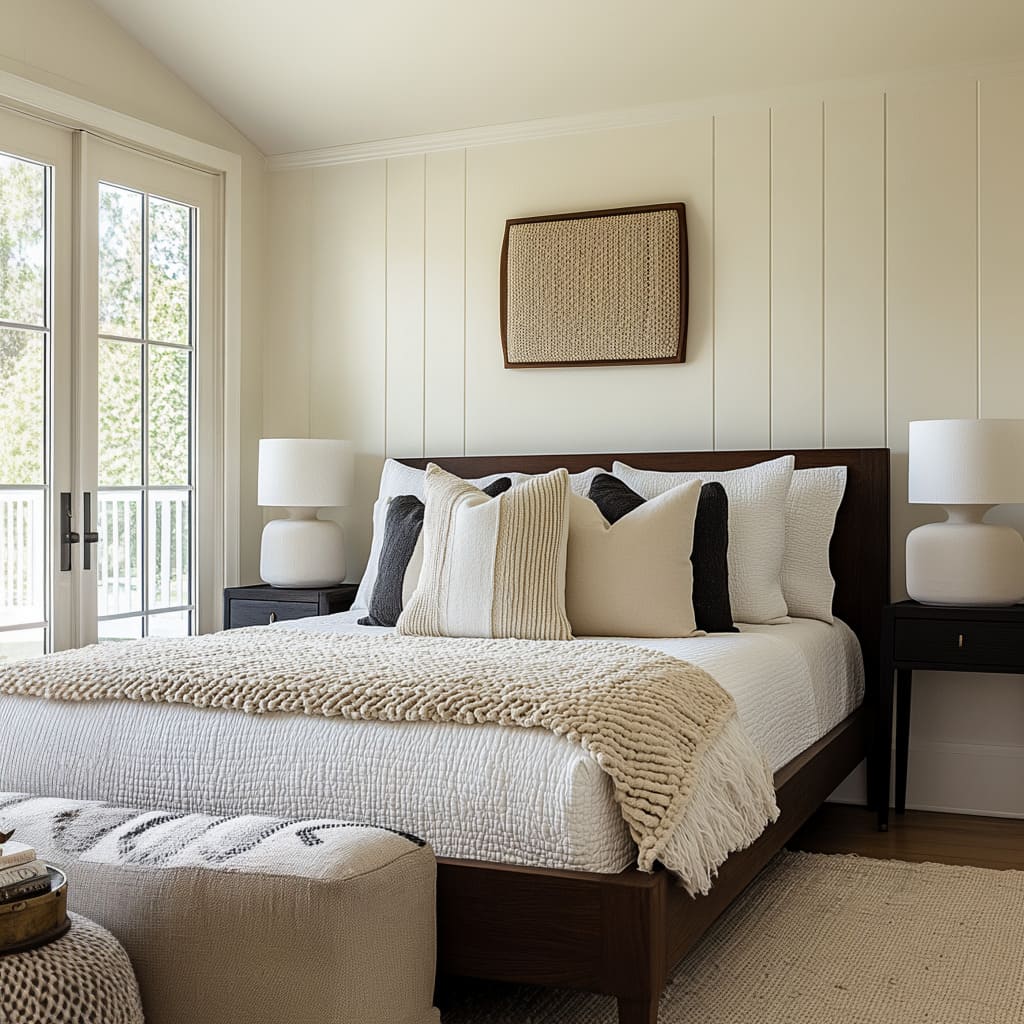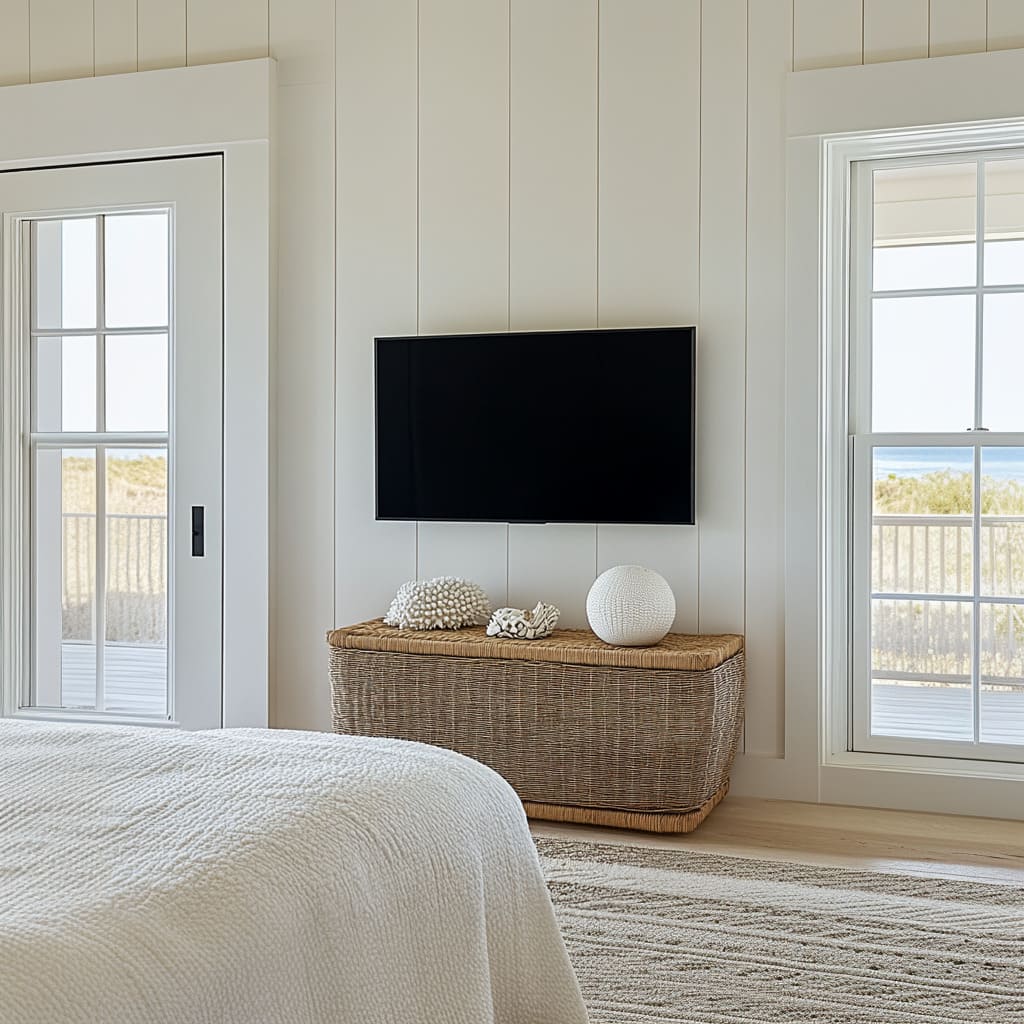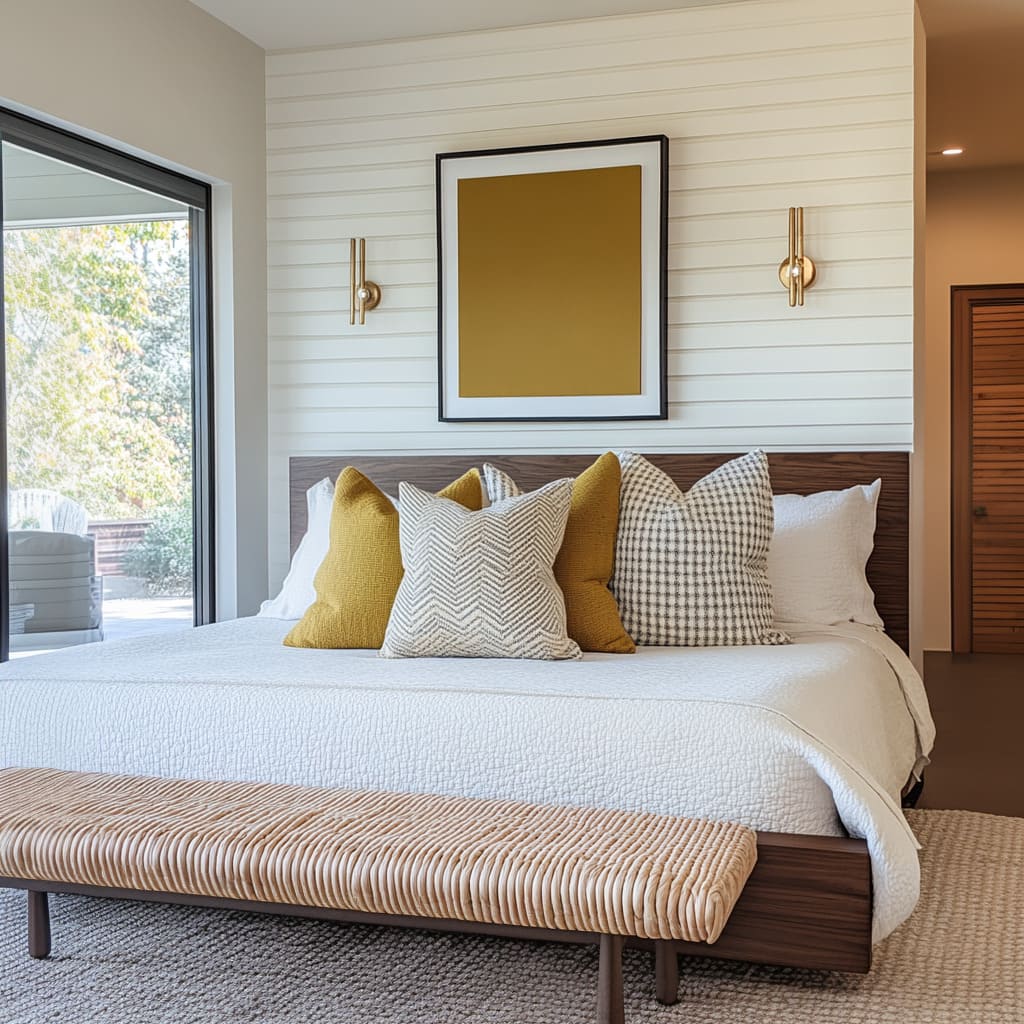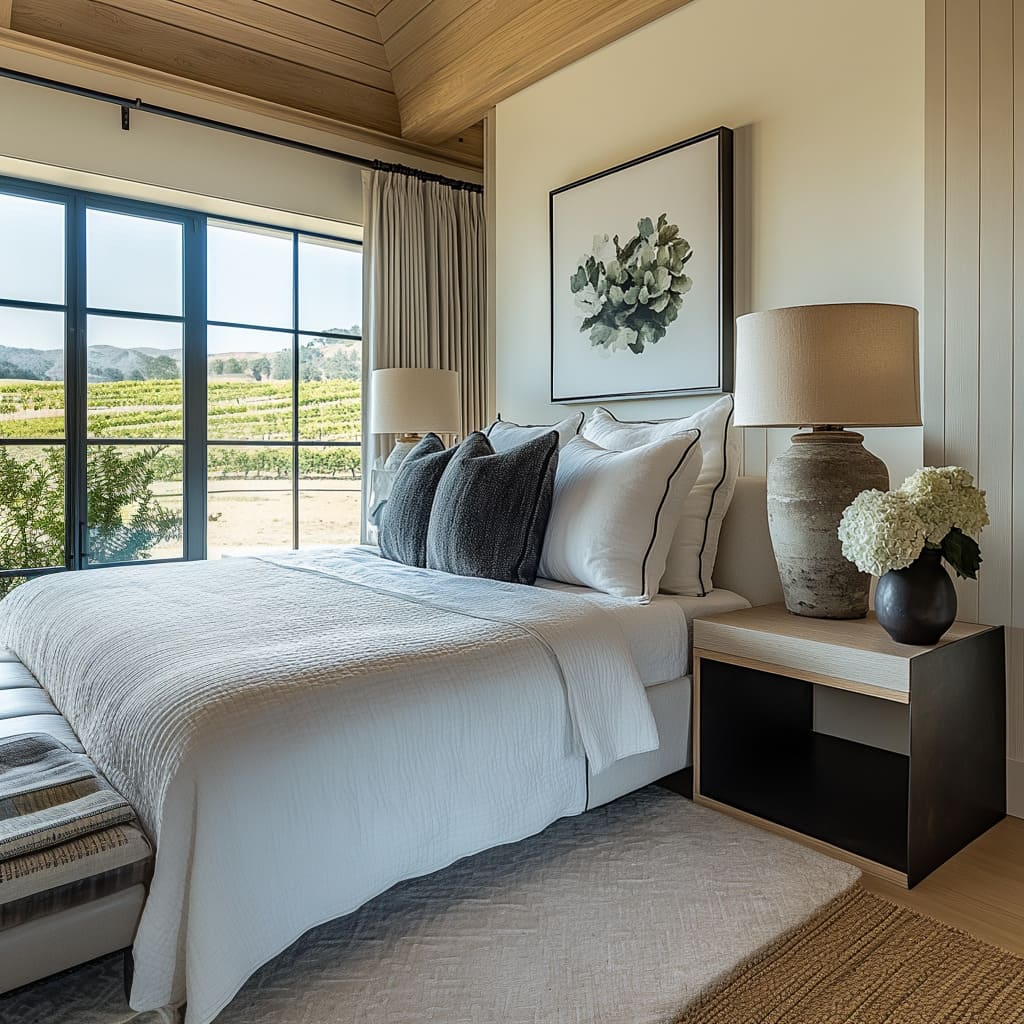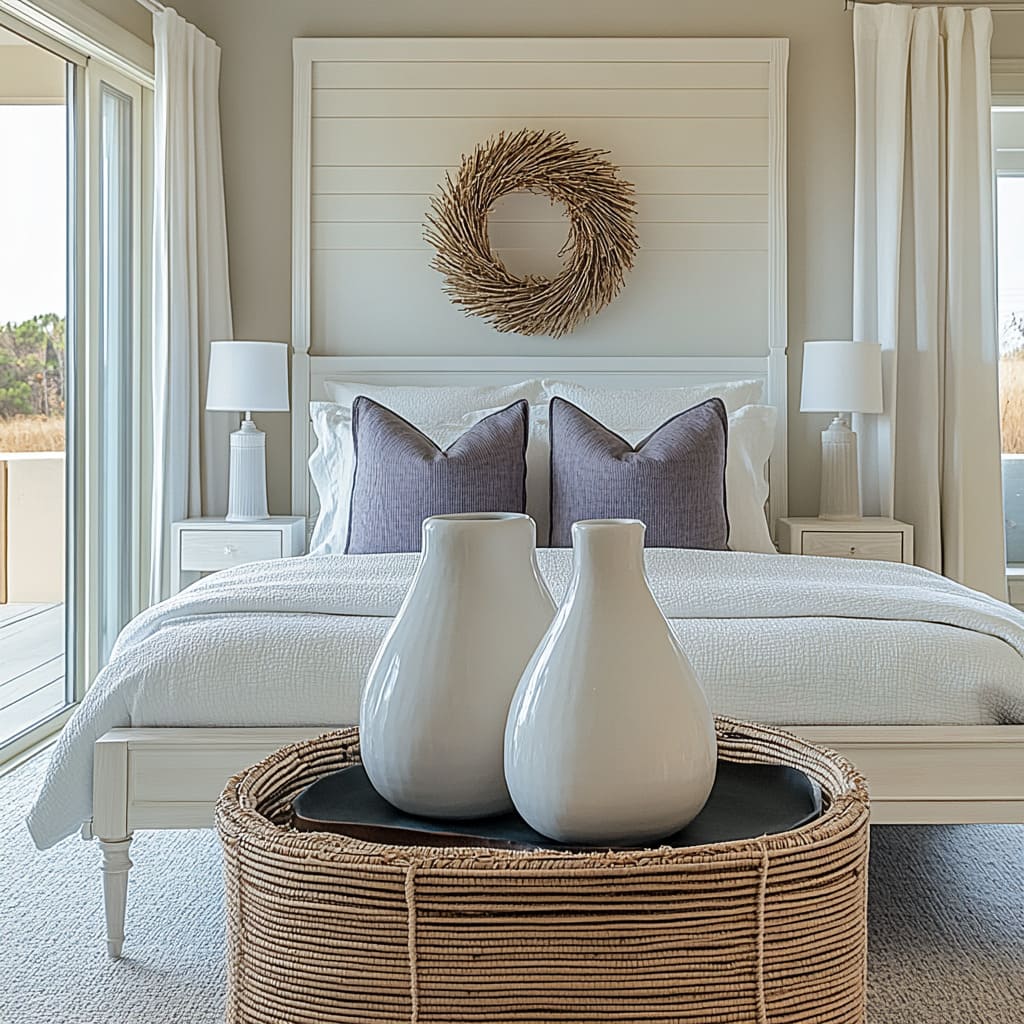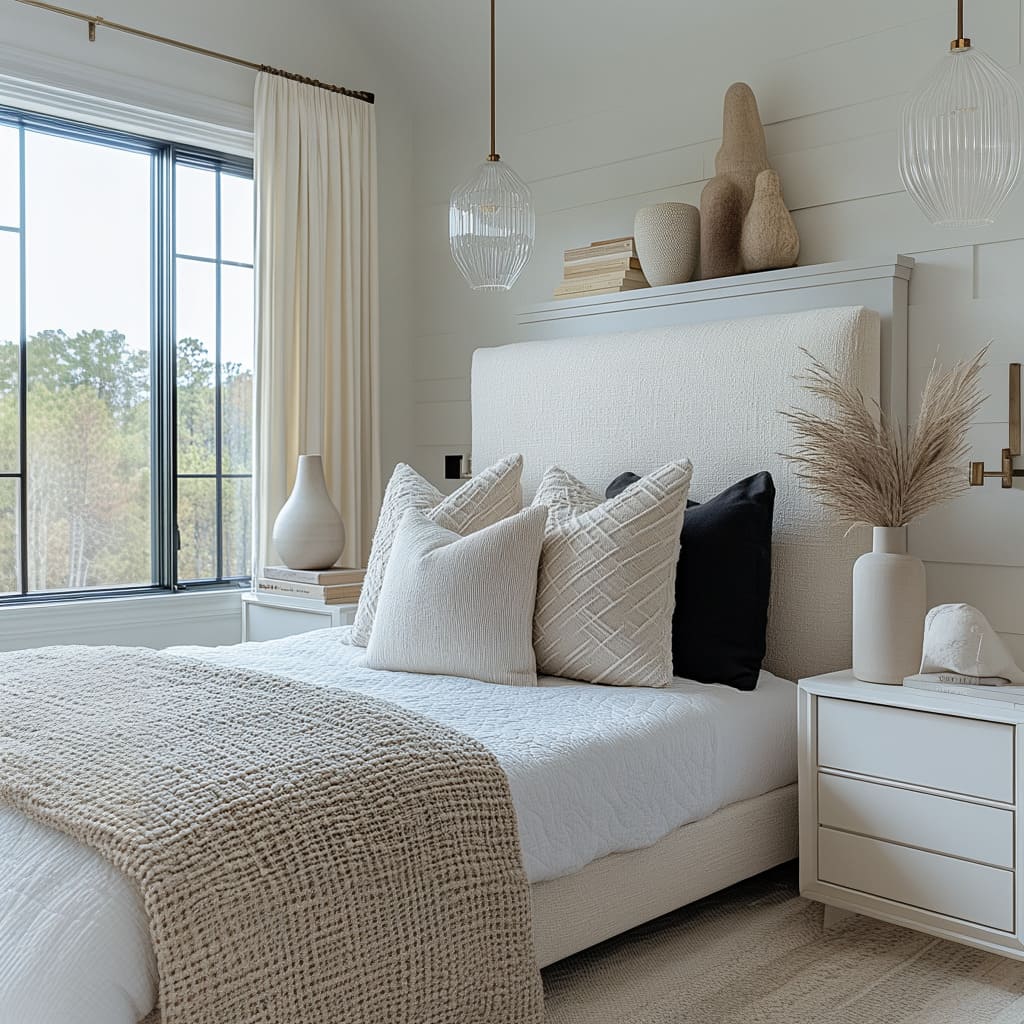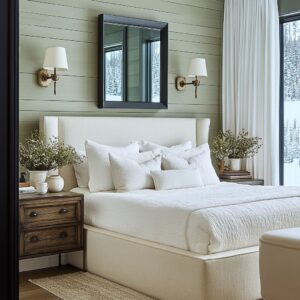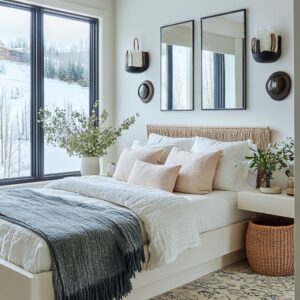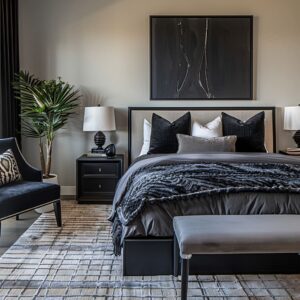Transforming a simple bedroom into a beautiful and functional retreat doesn’t have to feel complicated. With the right approach, even a room with plain walls can become an inspiring and inviting space.
This article focuses on sharing actionable bedroom decorating ideas that balance practicality with style. Whether you’re drawn to minimal designs or prefer spaces full of personality, we’ll explore how furniture, colors, textures, and accessories can work together seamlessly.
Using insights from various styles across the globe, you’ll find tips to bring charm and comfort to your room without overwhelming it. From clever use of textures to strategic furniture placement, these suggestions will help you create a bedroom that’s both visually appealing and perfectly suited to your needs.
Emphasis on a Focal Point
Creating a standout feature in a bedroom is one of the most effective ways to design a space that feels intentional and visually appealing. A well-chosen focal point draws the eye and anchors the entire room, often becoming the centerpiece around which other design choices revolve.
Let’s explore how simple additions like headboards, accent walls, and artwork can transform the look of a bedroom while offering practical bedroom decorating ideas.
Headboards as the Highlight
Headboards are more than just functional—they can become the star of the room. Woven rattan headboards bring in an earthy, natural vibe, adding both warmth and a tactile element to the design.
On the other hand, upholstered headboards in neutral tones or with subtle geometric patterns create a polished and structured feel, ideal for modern interiors. Choosing a headboard with a distinctive texture or an unusual shape can effortlessly make the bed the centerpiece of the room.
Accent Walls for Contrast
Introducing an accent wall is a simple yet powerful way to frame the bed. Darker tones like black or terracotta provide depth and drama, offering a striking contrast to lighter surrounding walls.
Alternatively, muted pastels such as sage green or dusty blue lend a calming touch while still making a statement. Painted or paneled, these walls set the stage for the bed, complementing headboards and decor with a thoughtful color choice.
Artwork That Completes the Scene
Artwork plays a vital role in tying a room’s design together. A large, framed piece hung above the bed doesn’t just fill the empty space—it adds character.
Abstract art and nature-inspired prints are popular choices, blending effortlessly with organic or contemporary styles. The key is to align the artwork with the bed’s proportions, ensuring balance and harmony while enhancing the overall color palette of the room.
Simple Guidelines for Success
- Opt for a headboard with bold texture, materials, or shapes that complement the overall design.
- Use an accent wall to enhance the bed’s prominence, matching its tones to the headboard or surrounding decor.
- Select artwork that resonates with the room’s style and colors, positioning it carefully above the bed for a cohesive finish.
By thoughtfully emphasizing a focal point, your bedroom can achieve a stylish and cohesive look without overwhelming the simplicity of its walls.
Layering for Depth and Comfort
Creating a cozy and visually engaging bedroom is all about layering. This approach brings dimension and richness to even the simplest designs, making the space feel more welcoming and thoughtfully curated.
From the bed to the flooring and window treatments, layering introduces depth, enhances comfort, and transforms a room’s atmosphere.
Layered Bedding That Speaks of Comfort
The bed often serves as the centerpiece of the bedroom, and layering bedding is an excellent way to make it stand out. Start with a textured quilt or duvet in neutral tones, which provides a subtle yet structured foundation.
Add a chunky knit or woven throw, ideally in a complementary shade, for visual variety and extra warmth. Pillows are key to creating interest—mix geometric designs, stripes, and solid hues to avoid a uniform look.
Arranging pillows in varied sizes, from large Euro shams to smaller decorative cushions, adds a touch of refinement.
Rugs That Ground the Room
Flooring plays an essential role in anchoring the bedroom’s design. Natural woven rugs, such as those made of jute or wool, not only bring in texture but also offer warmth underfoot.
These rugs work particularly well in neutral color palettes with subtle patterns, as they provide a balanced contrast without overwhelming the decor. In small spaces, rugs can also define the layout by framing the bed and adjacent furniture, a practical tip for those exploring small bedroom ideas.
Curtains That Enhance Vertical Space
Window treatments are often overlooked, but they are instrumental in setting the tone of the room. Full-length curtains in light, airy fabrics like linen or cotton soften incoming natural light and make ceilings appear higher, visually expanding the room.
Light-colored curtains in off-whites, creams, or soft greys maintain an understated elegance while complementing a variety of decor styles. For added depth, consider layering sheer panels underneath for more flexibility with light control.
Guidelines for Thoughtful Layering
- Incorporate a mix of textures in your bedding, such as quilted duvets and knit throws, to keep the design dynamic.
- Use natural rugs with minimal patterns to tie the room together, especially when other elements are simple.
- Choose soft, full-length curtains that enhance the light and vertical space, creating an inviting and open feel.
When done thoughtfully, layering can transform a plain bedroom into a warm, textured retreat, offering a perfect blend of comfort and style.
Thoughtful Use of Color
The way color is applied in a bedroom can completely shape its ambiance and character. Simple yet impactful strategies, such as starting with a neutral base and strategically layering tones, can elevate a space into something visually cohesive and calming.
Let’s explore how to make color work to your advantage in bedroom decor while keeping it stylish and inviting.
Neutral Foundations for Flexibility
A neutral base is the cornerstone of many successful bedroom designs. Walls painted in soft whites, creams, or light beiges provide a clean and versatile backdrop that allows other design elements to shine.
Larger furniture pieces, like beds or nightstands, often follow the same neutral palette to ensure the room feels cohesive. This approach not only enhances the sense of calm but also leaves room for other colors to take the spotlight without creating visual clutter.
Accents That Catch the Eye
To add vibrancy and depth, small decor items such as cushions, throws, or vases introduce complementary accent colors. Bold tones like mustard, navy, or terracotta are often used sparingly to create contrast against the neutral foundation.
For example, a set of mustard-colored cushions on a cream bedspread instantly enlivens the space while maintaining balance. These pops of color help inject personality without overwhelming the overall design.
Layering Tones for Subtle Sophistication
Using multiple shades of the same color family is a subtle yet effective technique to create depth. For instance, layering various shades of beige—ranging from sand to taupe—can make the room feel rich and multidimensional while keeping the overall scheme cohesive.
This technique is particularly effective for bedding and rugs, where textural differences further emphasize tonal variations. Layering tones adds visual interest without breaking the calm atmosphere of the bedroom.
Guidelines for Color Application
- Begin with neutral tones for walls and larger furniture, ensuring a flexible and soothing foundation.
- Add accent colors sparingly through accessories like pillows, lamps, or artwork, keeping them bold enough to contrast yet harmonized with the base palette.
- Experiment with different shades within the same color family to introduce depth while keeping the design cohesive.
Whether you’re exploring bedroom color ideas for a complete makeover or subtle enhancements, these principles can guide you in creating a stylish and tranquil retreat. By thoughtfully incorporating neutral tones, complementary accents, and layered hues, you can achieve a look that feels curated and effortlessly inviting.
Textures for Visual and Tactile Interest
Incorporating a variety of textures is a highly effective way to add depth and character to a basic bedroom design. By blending materials that contrast and complement each other, you can transform a plain room into a space that feels dynamic and inviting.
Textures not only elevate the visual appeal but also provide a tactile layer that makes the room more comfortable and engaging.
Natural Materials for Organic Charm
Using materials like rattan, wicker, and jute in headboards, rugs, and light fixtures introduces a natural, earthy vibe to the bedroom. These elements evoke a sense of simplicity and connection to nature while breaking the monotony of smooth, industrial finishes.
For instance, a woven rattan headboard paired with a neutral wall color creates a warm focal point, perfect for spaces aiming to feel calm yet stylish.
Balancing Rough and Smooth
Contrast is crucial when working with textures. The rough, organic look of woven materials is beautifully balanced by smoother finishes on furniture, table lamps, or polished wood nightstands.
This interplay ensures that the room doesn’t lean too heavily into one style, striking a balance between rustic and refined. For example, pairing a chunky knit throw with a sleek, minimalist bedside table adds both warmth and sophistication.
Tactile Layers for Comfort
In bedrooms with simple decor, tactile accents prevent the space from feeling lifeless. Textured bedding, such as quilted duvets or chunky knit blankets, provides visual interest while enhancing comfort.
Ribbed ceramic vases or woven baskets can be added to create further layers of tactile appeal, tying these elements into the room’s broader aesthetic. These touches not only invite touch but also make the space feel more personal and grounded.
Guidelines for Using Textures Effectively
- Mix smooth and textured finishes to create a balanced and cohesive look that feels neither too polished nor overly rustic.
- Use tactile accents like knitted throws, woven rugs, or ribbed ceramics to add depth and warmth to spaces with minimal decor.
- Incorporate natural materials such as wood, rattan, or wicker to bring in an organic element that complements neutral or muted color palettes.
These tips align seamlessly with bedroom design ideas that focus on combining functionality with style. By thoughtfully layering textures, you can create a room that is as visually captivating as it is comfortable, making the simplest bedroom feel carefully curated and richly detailed.
Furniture Functionality and Placement
Thoughtful furniture selection and arrangement are essential for creating a balanced, practical bedroom that feels both inviting and spacious. By focusing on multifunctional pieces and strategic placement, you can achieve a harmonious setup that enhances the room’s usability without compromising on style.
Efficient Use of Side Tables
Compact side tables with clean lines are a staple in many bedroom designs, offering both practicality and visual appeal. Opt for pieces with built-in storage, such as drawers, to keep surfaces tidy and clutter-free.
Light wood tones or matte finishes are particularly effective, as they seamlessly blend with neutral color palettes, maintaining a cohesive look. Side tables not only provide a spot for essentials like lamps or books but also contribute to the room’s structured aesthetic.
The Role of Benches and Ottomans
Adding a bench or ottoman at the foot of the bed is an excellent way to enhance both functionality and design. These pieces serve multiple purposes, from additional seating to extra storage space.
A padded bench, for example, softens the room while complementing the bed’s overall composition. Whether upholstered in fabric or featuring natural wood finishes, these elements help anchor the bed and create a visually complete arrangement.
Minimalist Furniture Arrangements
A minimalist approach to furniture selection is key to maintaining an open and airy atmosphere. Avoid overcrowding the space by limiting furniture to essential pieces.
This not only enhances the functionality of each item but also makes the room feel larger and more comfortable. For example, a simple bed frame paired with streamlined nightstands keeps the layout sleek and uncluttered, while still providing necessary utility.
Practical Guidelines for Furniture Selection and Placement
- Choose multifunctional furniture, like side tables with storage or ottomans that double as a place to stow blankets.
- Define the foot of the bed with a bench or ottoman to add structure and utility without overwhelming the layout.
- Maintain open spaces by prioritizing essential items, ensuring the room feels spacious and uncluttered.
Incorporating these strategies aligns perfectly with master bedroom furniture ideas, helping you create a space that is both stylish and functional. By balancing furniture selection with careful placement, you can transform a simple bedroom into a refined retreat that maximizes its potential.
Lighting as a Design Feature
Lighting plays a transformative role in bedroom design, both as a functional necessity and a creative tool for enhancing the room’s aesthetic. By layering different light sources and selecting fixtures with style in mind, you can make lighting an integral part of the room’s decor.
Layering Light for Versatility
One of the most effective approaches is using a combination of sconces, table lamps, and overhead lighting to create a layered effect. This not only ensures the room is well-lit for various activities but also allows for adjustments in ambiance.
Table lamps placed on bedside tables provide focused light for reading, while overhead fixtures like pendant lights or chandeliers illuminate the space broadly. Wall sconces are particularly practical for small bedrooms, as they save space and add a sculptural element.
Decorative Fixtures That Stand Out
Lighting fixtures can do more than brighten a room—they can act as statement pieces. Woven pendants, for example, introduce texture and a natural aesthetic, while brass sconces add a touch of sophistication.
Even when switched off, these fixtures contribute to the overall style of the room. This thoughtful use of materials ensures that lights are not only practical but also visually striking.
Maximizing Natural Light
Natural light remains an invaluable asset in bedroom design. Large windows and glass doors help flood the space with daylight, creating an open and airy feel.
To maintain privacy while still allowing light to filter in, sheer curtains woth a window scarf or light-filtering blinds are excellent options. These treatments soften the sunlight and highlight the architectural features of the windows.
Guidelines for Lighting in Bedroom Design
- Choose lighting fixtures that complement the room’s style, whether through material (like metal or wicker) or form.
- Invest in dimmable lights for flexibility, making it easy to transition between bright functional lighting and a softer ambiance.
- Embrace natural light by using unobtrusive window treatments that don’t block the flow of light.
By thoughtfully incorporating lights in bedroom ideas, you can enhance both the functionality and design of the space. Whether through striking fixtures or strategic placement, lighting has the power to elevate the room, making it feel brighter, more welcoming, and uniquely stylish.
Small Decor and Accessories
Small decor and accessories are the finishing touches that bring character and harmony to a bedroom. Thoughtfully chosen elements like vases, books, and mirrors can elevate the design without overwhelming the space, making even the most understated rooms feel complete and intentional.
Organic Movement Through Greenery
Adding life and movement to the bedroom is as simple as incorporating greenery or dried botanicals. Neutral ceramic or glass vases filled with pampas grass, eucalyptus, or other natural elements soften the room’s sharp lines and complement its textures.
These organic additions provide a subtle pop of visual interest while blending seamlessly with neutral or earthy color schemes.
The Power of a Well-Placed Book
Books are not only functional but also decorative when displayed purposefully. Stacked books on bedside tables or dressers introduce layers and a curated aesthetic.
By selecting covers that align with the room’s palette—perhaps in muted tones or monochromatic hues—you can ensure they enhance the design rather than distract from it. This creates a relaxed, personal touch that feels intentional without being overbearing.
Expanding Spaces With Mirrors
Mirrors serve both functional and aesthetic purposes. Strategically placed mirrors can amplify light, reflect natural brightness, and give the illusion of a larger space, making them particularly useful in compact bedrooms.
Positioning a mirror to capture and reflect outdoor views or natural light can visually expand the room, making it feel more open and airy. Framed mirrors in materials like wood or metal can also reinforce the room’s style.
Practical Guidelines for Small Decor
- Use small decor items sparingly to maintain a clean and uncluttered look. Less is often more when aiming for an elevated design.
- Choose materials like ceramic, wood, or glass for accessories, ensuring they harmonize with the textures already present in the room.
- Place mirrors thoughtfully to reflect natural light or key design elements, enhancing both functionality and aesthetics.
Incorporating these master bedroom decor ideas can transform even the simplest bedroom into a stylish, inviting retreat. By balancing functional and decorative elements, the room feels personalized yet cohesive, achieving a design that’s both timeless and refreshingly modern.
Principles of Composition and Balance
Achieving a harmonious and visually pleasing bedroom relies heavily on well-thought-out composition and balance. These principles guide the placement of furniture, decor, and accessories to create a space that feels cohesive and uncluttered.
By focusing on symmetry, layering heights, and utilizing negative space, you can craft a bedroom interior design that is both functional and aesthetically appealing.
Symmetry for a Balanced Look
Symmetry is a time-tested approach to creating order and balance in a bedroom. Matching side tables flanking the bed, each topped with identical lamps, not only look visually pleasing but also create a sense of stability.
Pillows arranged symmetrically on the bed contribute to this effect, ensuring the overall design feels deliberate and harmonious. While symmetry is key, slight variations—such as differing decor items on the side tables—can add personality without disrupting balance.
Dynamic Heights for Visual Interest
Incorporating decor of varying heights introduces layers and prevents the room from appearing flat. For instance, tall vases or plants can draw the eye upward, while medium-height lamps and lower objects like trays or books anchor the composition.
This variation in height establishes a dynamic hierarchy, making the space feel more engaging. The key is to ensure these elements complement one another and maintain cohesion in style and color.
Negative Space for Breathing Room
Negative space, or the intentional use of empty areas, is essential for creating a room that feels spacious and uncluttered. Allowing gaps between furniture and avoiding overcrowding ensures that each design element stands out.
For example, leaving a clear area around the bed or between larger furniture pieces gives the room a more open and breathable feel, emphasizing simplicity and elegance.
Guidelines for Balanced Composition
- Prioritize symmetry in key areas, such as side table and lamp arrangements, to maintain a structured and harmonious design.
- Layer decor items of varying heights, ensuring each piece contributes to a cohesive and visually dynamic setup.
- Incorporate negative space by carefully spacing out furniture and decor, allowing the room to feel open and inviting.
By applying these principles of composition and balance, you can achieve a bedroom that is visually organized and effortlessly stylish. These strategies help create a sense of flow and order, making any bedroom interior design feel intentional and polished.
New Design Ideas
Adding fresh and unexpected elements to your bedroom design can transform the space into something truly unique. By experimenting with textures, subtle patterns, and natural elements, you can create a room that feels cohesive, grounded, and stylish.
These ideas focus on subtle enhancements that pack a big punch without overwhelming the overall design.
Accent Textures in Surprising Places
Textures are a powerful tool in design, and using them creatively can redefine a room’s character. Consider textured wood paneling or fabric wall coverings as accent walls—they add dimension without overpowering the space.
Even light fixtures with intricate details or unique finishes can serve as subtle texture accents, elevating the design. For example, a ribbed ceramic lamp or a woven pendant light can introduce depth while blending seamlessly with neutral tones.
Layering Neutral Patterns for Subtle Depth
A monochromatic palette doesn’t have to be boring when paired with thoughtful patterns. Geometric designs, ribbed surfaces, or woven materials in similar shades create a layered look that feels sophisticated yet calm.
For instance, pairing a quilted duvet with striped or herringbone-patterned cushions offers visual variety without straying from a cohesive color scheme. This approach ensures the room remains unified while avoiding visual flatness.
Bringing in Natural Elements
Nature-inspired materials and decor are excellent ways to connect the bedroom to the outdoors. Dried florals in muted tones, woven baskets, and earthy-toned rugs contribute warmth and a sense of grounding.
For a balanced aesthetic, incorporate these elements in moderation, such as adding a vase of pampas grass or a wooden bench at the foot of the bed. These touches enhance relaxation and bring an organic feel to the room.
Guidelines for Fresh Design Ideas
- Use textures thoughtfully by integrating them into unexpected areas, such as headboards, wall coverings, or lighting fixtures.
- Layer neutral patterns in bedding, rugs, and curtains to maintain interest without overwhelming the space.
- Include natural elements, such as dried botanicals or woven materials, to foster a connection between the room and its surroundings.
Applying these creative ideas for interior decoration for bedroom spaces can result in a design that feels both modern and timeless. By focusing on small yet impactful updates, you can create a room that reflects your personal style while staying grounded in thoughtful, cohesive design principles.
Conclusion
Transforming a simple bedroom into a space that feels stylish and inviting is all about balancing the right elements. From layering textures to using thoughtful focal points and cohesive color schemes, every decision contributes to a room that is both functional and visually appealing.
The key lies in curating details that work harmoniously without overwhelming the simplicity of the design.
By applying the principles discussed, such as incorporating natural materials, experimenting with accent textures, and thoughtfully arranging decor, you can achieve a bedroom that feels curated yet comfortable. Whether it’s layering soft bedding or placing a statement mirror to reflect natural light, these small yet impactful touches make a significant difference.
When looking for bedroom decor inspiration, remember that simplicity does not mean sacrificing character. It’s about intentional choices that reflect your style and make the most of the space.
With the right approach, even the most basic bedroom can become a refined retreat that feels uniquely yours.

